
 September 30, 2024 "Try To Remember The Kind of September"
September 30, 2024 "Try To Remember The Kind of September"
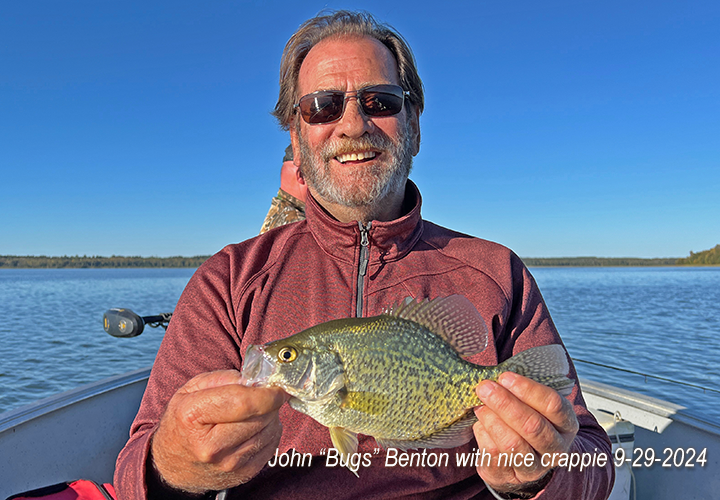 I closed yesterday’s update with a note that John Benton, his pal Dana and I were planning to try catching crappies in the morning, then shift to walleye fishing in the afternoon. I mentioned too that I’d let you know how that project turned out, so here’s the report.
I closed yesterday’s update with a note that John Benton, his pal Dana and I were planning to try catching crappies in the morning, then shift to walleye fishing in the afternoon. I mentioned too that I’d let you know how that project turned out, so here’s the report.
The crappie fishing was better than I expected, we lucked into finding 3 sperate schools of fish that were closely gathered and vulnerable to vertical jigging. The schools were not large enough to provide steady action for more than 10 or 15 minutes, but while the fish were biting, they were biting well.
The key depth was about 12 feet, but we found one of the schools in about 15 feet of water. Typical of late summer, early spring locations, the fish were gathered near stumps or branches laying near the bottom. The structures are small but offer cover sufficient to hold small groups of crappies. The best way to search for the small snags is by using side imaging, but you can locate them without it. In the past, I’ve discovered lots of them accidentally when trolling spinners as we’ve gotten snagged on them. Then there were times I observed the small structures on sonar as we passed over them and marked the spot on my GPS chart. No matter how you find them, keep track of them because eventually, they’ll hold panfish.
Like I said, we used jigs yesterday and it was the first time this season, that for me, spinners were never deployed to search or catch. The 1/8-ounce live bait jigs tipped with small fatheads worked fine, but I did experiment with plastic tails. The artificials worked too, and I caught several crappies on the Strike King Mr. Crappie Slabalicious Soft Bait, and a couple on the 2-inch Ripple Shads as well. I planned to try others, but my experimentation was cut short by my crew reaching their legal limits of fish. So we 20 crappies in the tank, we rolled out to the big lake to try our hands at walleye fishing.
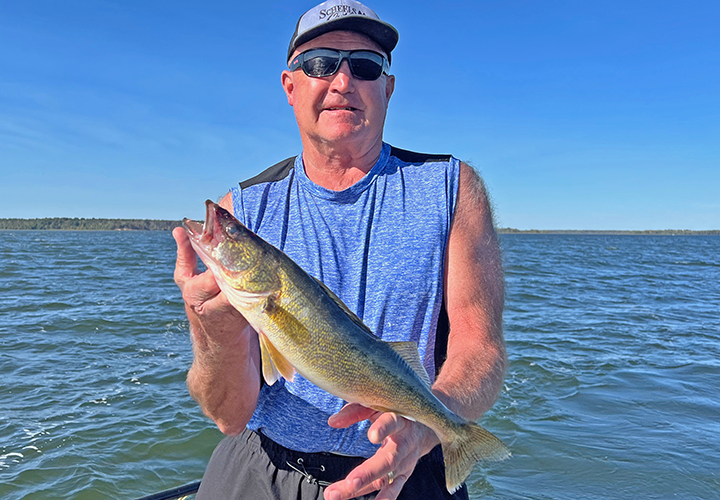 I guess it was about 11:00 AM, and the southeast wind was just beginning to increase, so setting up shop on the south side of the lake was our goal. By the time we got there, boat control over Winnie’s deep structure was still manageable, but not enjoyable. The walleyes on mid-lake bars, especially on the south end of the Bena Bar were not hard to locate, in fact I marked more fish than usual yesterday. When I stopped the boat, John picked up one of them almost immediately after stopping, but then the action stopped. I’m not sure why, but no matter what spot I stopped at, the mid-lake fish did not cooperate.
I guess it was about 11:00 AM, and the southeast wind was just beginning to increase, so setting up shop on the south side of the lake was our goal. By the time we got there, boat control over Winnie’s deep structure was still manageable, but not enjoyable. The walleyes on mid-lake bars, especially on the south end of the Bena Bar were not hard to locate, in fact I marked more fish than usual yesterday. When I stopped the boat, John picked up one of them almost immediately after stopping, but then the action stopped. I’m not sure why, but no matter what spot I stopped at, the mid-lake fish did not cooperate.
By now, the wind was strong enough to rule out heading for the west or north sides of the lake. So, I motored to the southwest corner to search for fish in the shallows. The plan was to fish a shallow section of the River Bar where I caught some fish a week or so back. One drift using jigs and minnows turned up nothing but weeds, and it was clear that I’d need to go into search mode. I pulled out Ugly Sticks and rigged the spinners up and started trolling back through the same section we’d just fished.
Now that we were trolling spinners, we had a whole new ball game going on. There were perch, pike and walleyes on that spot and we caught some of them, but not enough to hold us there. Trial and error, moving east from spot-to-spot eventually led us to a mixed school of fish that were more active. The key depth turned out to be 8 feet of water, but there were fish caught as shallow as 6, and as deep as 8 feet. Walleye sizes varied from about 8 inches, up to 19-1/2 inches, perch ranged between 4 and 11 inches, and there were numerous small to medium size pike. While we had decent action, maybe 1/3 of all the fish we boated were “keepers”, so the tally was modest, 5 walleyes, 10 perch and 1 northern pike. It seemed clear that the action improved later in the day, and if we’d stayed longer, we’d likely have caught more. But it’s 5:30 and there are lots of fish to clean, so we pulled the plug.
I won’t call the afternoon fantastic, but the action was good, and we bagged enough fish to call the plan successful.
Today, the last day of September, appears to be an historic one. We haven’t come close to having our first frost, surface water temperatures are still in the high 60s and fish have barely begun moving away from summertime haunts. As we roll into October, I’m pondering the idea of adding a few more trips to the schedule, but we’ll see about that.
Today’s forecast calls for increasing wind coming from the west and gusting to 30 MPH this afternoon. I won’t know for sure what I’ll do until I meet my crew and learn their preferences. Whatever we do decide on, I’ll let you know how it works out tomorrow. ![]() — Jeff Sundin, The Early Bird Fishing Guide Office Cell Call or Text 218-245-9858 or Email
— Jeff Sundin, The Early Bird Fishing Guide Office Cell Call or Text 218-245-9858 or Email
More Recent Fishing Reports
Crappies 9-29 • Lake Winnie 9-27 • Sundin 9-26 • Ely MN 9-25 • L.O.W 9-25 • Grand Rapids 9-24 • Winnibigoshish 9-23 • Bowstring 9-22 • Lake Winnie 9-19 • Sundin 8-18 • Brainerd 9-16 • Sundin 9-14 • Wary Walleyes 9-12 • Sundin 9-11 • Winnibigoshish 9-10 • MN DNR Workgroups • Sternberg 7-18 • Legal Bait Transport 6-1 • MN Record Fish • Barotrauma Study 1-25-24 • Fish Consumption • Forward Sonar • Panfish Workgroup • Follow on Facebook
 September 29, 2024 "Crappies on the Flats A Pattern To Remember"
September 29, 2024 "Crappies on the Flats A Pattern To Remember"
 Correct me if I’m wrong, but I believe that September will pass without the first frost in Itasca County. The cycle of warm daytime temperatures and cool, but moderate overnight lows is forecast to last at least a few more days. Fish seem happy about the extended pre-fall period and are not hard to catch. Finding them though, that can take a little more effort than some anglers anticipate.
Correct me if I’m wrong, but I believe that September will pass without the first frost in Itasca County. The cycle of warm daytime temperatures and cool, but moderate overnight lows is forecast to last at least a few more days. Fish seem happy about the extended pre-fall period and are not hard to catch. Finding them though, that can take a little more effort than some anglers anticipate.
Take the image you see below an example; it represents 5 crappies spread across a mid-depth flat on a small lake. The lake, roughly 300 acres in size with a max depth of 30 feet, is a typically reliable, fall crappie destination for me. Most often, the fish are “stacked up” vertically on the upper edges of the main basin by now. When they’re not, they usually inhabit the weeds adjacent to the shoreline, but right now, they are not located in either place.
What we found instead is nomadic singles, doubles and occasional small packs of crappie, spread far and wide over the flats. If I stopped and fished vertically with jigs and minnows, we could pick them off 1 or 2 at a time, but that method was tedious. The better choice was trolling, covering more water, and when our lures passed them, they struck, that’s the good news. But the slow-steady nature of this presentation still lacked a certain pizazz that my crew has associated with “normal” fall crappie fishing.
The setup we used was the typical single hook spinner behind a 3/16-ounce bullet sinker. The fish were suspended at random depths, so to cover a wider section of the water column, split shot sinkers of varying weights were added just behind the bullet sinkers. To be sure our lines don’t get tangled while trolling, the front line has the lightest weight, line #2 is slightly heavier, line #3 has a heavier weight and so on. Because each angler covers a slightly different depth, we trigger more strikes overall.
The system was working, so I stuck with it. Sometimes though I can accomplish the same thing by using jigs tipped with plastic action tails like twisters, shad bodies and the like. If the spinners had failed, that would have been my next experiment, and it typically does work too. So, if you find yourself in a similar scenario and you prefer jigging over spinning, start with that as your first experiment instead.
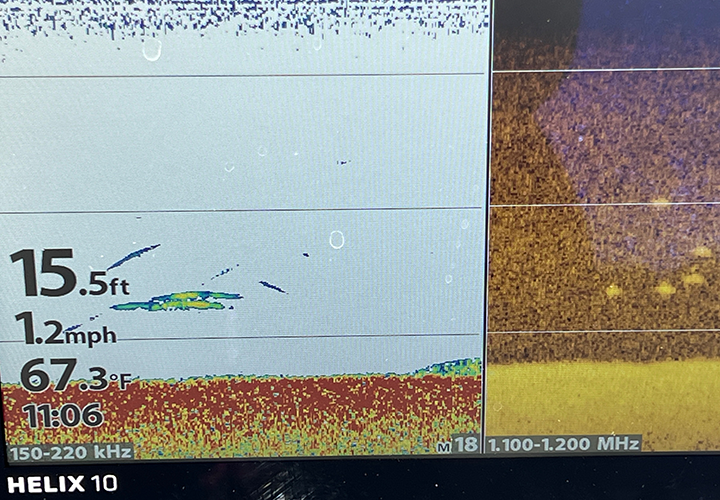 The term “flat”, for me, describes the expanse of water between the shoreline, and the mid lake basin. It’s the area where depths vary little, if at all, and fish do not relate to specific structures like drop-offs, rock piles or brush piles. The depth of the flats on this small lake ranged from about 12 to 16 feet deep, but could occur deeper, or shallower, depending on how your favorite lake is put together. I have seen this pattern before on flats as shallow as 10 feet deep, all the way down to flats with 20 feet of water or more.
The term “flat”, for me, describes the expanse of water between the shoreline, and the mid lake basin. It’s the area where depths vary little, if at all, and fish do not relate to specific structures like drop-offs, rock piles or brush piles. The depth of the flats on this small lake ranged from about 12 to 16 feet deep, but could occur deeper, or shallower, depending on how your favorite lake is put together. I have seen this pattern before on flats as shallow as 10 feet deep, all the way down to flats with 20 feet of water or more.
I can’t say if the flats pattern is weather related, or if it’s just part of the routine seasonal movement of crappies in certain waters. What I do know is that when I can’t find crappies stacked up near deep basins, and when I don’t find them in the weeds either, then these flat areas are usually where they are. So, if you’re not seeing crappies where you expect to find them this fall, check out this pattern to see if it works for you too.
Today, we’re going to try for the daily double, hopefully catching some crappies in the morning, then some walleyes in the afternoon. If it works, I’ll tell you all about it in the morning, if it doesn’t, I’ll tell you all about it in the morning too. ![]() — Jeff Sundin, The Early Bird Fishing Guide Office Cell Call or Text 218-245-9858 or Email
— Jeff Sundin, The Early Bird Fishing Guide Office Cell Call or Text 218-245-9858 or Email
 Cutfoot Sioux, Lake Winnie Fishing Report September 27, 2024
Cutfoot Sioux, Lake Winnie Fishing Report September 27, 2024
 "One thing is certain, walleyes are biting when we find them. The caveat, is finding them and the anglers who want to be most consistent, must fish a wider variety of structures and be willing to think about both fall, and summertime fishing patterns at the same time.
"One thing is certain, walleyes are biting when we find them. The caveat, is finding them and the anglers who want to be most consistent, must fish a wider variety of structures and be willing to think about both fall, and summertime fishing patterns at the same time.
According to the calendar, we should be experiencing solid fall walleye fishing patterns. And we almost are, we had a “spurt” of fall weather last week, and walleyes responded well, and in some areas of the lake, so did perch. Now, we’re back into a period of summer-like weather, Surface temperatures are in the 66-to-70-degree range, and there’s been lots of sunshine and calm weather. Daytime anglers may be working harder at producing consistent catches of walleyes, but folks who fish during prime time, twilight periods are having better luck.
On Big Winnie, there are two massive, mid-depth flats, one at the northwest corner, one at the southeast corner. On these flats, walleyes, perch and pike of all sizes can be viewed constantly on the screens of our electronics. Sometimes they bite, sometimes they don’t, but they have been located over the tops of low-lying vegetation for weeks now. According to our family friend Dusty Snyder, the magic water depth to catch them is ..." Read >> Bowen Lodge Lake Winnie Fishing Report September 27, 2024
 Wired2Fish Septmber 27, 2024 "How to Fish a Ned Rig | Jacob Wheeler’s Top 4 Techniques"
Wired2Fish Septmber 27, 2024 "How to Fish a Ned Rig | Jacob Wheeler’s Top 4 Techniques"
 "Say what you want, but finesse spinning techniques are essential for consistently catching neutral to negative bass. Jacob Wheeler knows this well. He shares his top four methods for rigging a Ned rig, offering a fresh perspective on how to maximize its effectiveness. Whether you’re looking to fish in shallow or deeper water, Wheeler’s techniques are designed to help you catch more fish, especially when conditions are tough. Check out our Ned Rig Tips library for more in-depth information.
"Say what you want, but finesse spinning techniques are essential for consistently catching neutral to negative bass. Jacob Wheeler knows this well. He shares his top four methods for rigging a Ned rig, offering a fresh perspective on how to maximize its effectiveness. Whether you’re looking to fish in shallow or deeper water, Wheeler’s techniques are designed to help you catch more fish, especially when conditions are tough. Check out our Ned Rig Tips library for more in-depth information.
The classic way to fish a Ned rig is with an exposed jig head, often in the 3/16-ounce range. Wheeler highlights how this traditional rig works best with small baits, such as a 3-inch stick bait, especially in stained water where a chartreuse jig head can offer an added visual edge. He emphasizes the importance of ..." Learn More >> How to Fish a Ned Rig | Jacob Wheeler’s Top 4 Techniques
 September 26, 2024 "Satisfactory Satisfaction at the Pike-Hole"
September 26, 2024 "Satisfactory Satisfaction at the Pike-Hole"
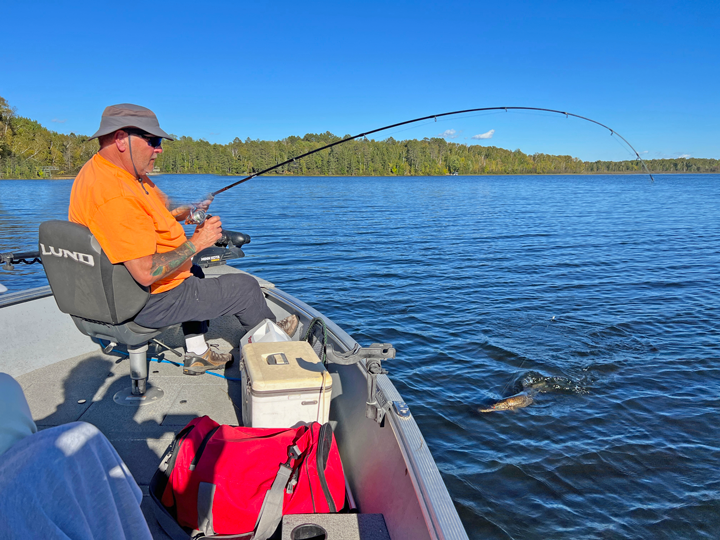 Northern Pike made it to the top of Kyle and Karen’s priority list for our fishing trip on Wednesday. Crappies were still up there too but weren’t an urgent part of the overall game plan. Hoping that we could fish for both at the same time, I selected a couple of small lakes that have decent populations of both. One, a 400 plus acre lake, the other, a larger, 800-acre lake. Both lakes have moderate, 7-foot water clarity and good reputations as panfish lakes. Neither or the lakes have an especially good pike population, but when we find the pike, the average size is decent. On Wednesday, the surface temperature at both lakes ranged between 67 and 69 degrees.
Northern Pike made it to the top of Kyle and Karen’s priority list for our fishing trip on Wednesday. Crappies were still up there too but weren’t an urgent part of the overall game plan. Hoping that we could fish for both at the same time, I selected a couple of small lakes that have decent populations of both. One, a 400 plus acre lake, the other, a larger, 800-acre lake. Both lakes have moderate, 7-foot water clarity and good reputations as panfish lakes. Neither or the lakes have an especially good pike population, but when we find the pike, the average size is decent. On Wednesday, the surface temperature at both lakes ranged between 67 and 69 degrees.
Trolling spinners on the weed edges, for almost 4 months now, has been a great way to locate both crappies and pike. Yesterday though, that strategy failed, we did not catch a single crappie on either lake by trolling spinners. The crappies we did catch, and there weren’t a lot of them, came by vertical jigging with 1/8-ounce live bait jigs tipped with fatheads. Additionally, those few crappies were all caught on the first lake, lake number 2 produced pike, but not a single crappie.
Spinners did attract plenty of pike strikes, but the fish were not where I expected to find them. Large weed flats adjacent to deep water have held northerns all summer long. Yesterday, trolling the weed edges produced very few of them, and the ones we caught there were smaller than usual. It wasn’t until I abandoned the weeds and moved to a steep, near shore breakline that we began to enjoy good action.
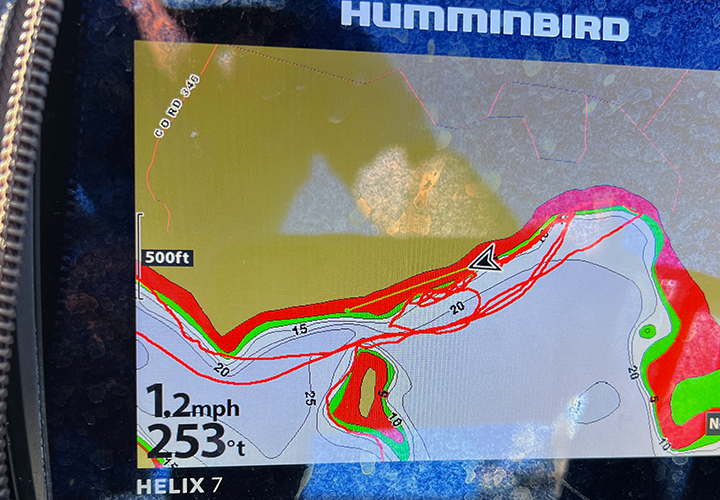 The image of my GPS chart plotter shows the contour of one of our better spots. A steep drop-off located close to the shoreline, and absent any sort of expansive weed flat. There were weeds growing along the breakline, but for us, getting too close to them was a waste of time. Pike were located a foot or two deeper than the edge of heavy growth, in the clear space between the breakline and the lake’s deeper basin. The key depth on this lake was 14 feet of water, depths on your lake will vary depending on water clarity, and depth of the weed lines.
The image of my GPS chart plotter shows the contour of one of our better spots. A steep drop-off located close to the shoreline, and absent any sort of expansive weed flat. There were weeds growing along the breakline, but for us, getting too close to them was a waste of time. Pike were located a foot or two deeper than the edge of heavy growth, in the clear space between the breakline and the lake’s deeper basin. The key depth on this lake was 14 feet of water, depths on your lake will vary depending on water clarity, and depth of the weed lines.
Like I said, spinners worked great for catching the pike, so we didn’t try any other presentations. The typical 3/16-ounce bullet sinker was used to get the blades into position. We were likely trolling them about 8 to 10 feet deep, well above the bottom.
For us, harvesting the pike was an important part of the plan, so we had to do some sorting. There were several fish in the protected slot size range, along with a couple of over-size fish. The ones we bagged, 9 of them, were as close to the low-end threshold as possible, just over 21 inches mostly. We did not harvest any fish over the high-end limit, but as you can see in the photo above, did catch and release some larger ones.
One tip for selecting the best pike to clean and cook, is to select fatter fish, vs longer ones. Examine the physique of each fish you catch, and you’ll notice that they vary a lot. For me, a fat 19 inch pike is more desirable than a skinny 21-3/4-inch fish. Often, even fish that are over the high size threshold are immediately released by me because they are too skinny. I’ve learned over time that those skinny fish do not clean easily, the yield of useable fillets is low and the fish are not very tasty.
When we were fishing on Winnie a few days ago, Karen caught a northern pike that had some odd-looking tumors on it’s side. I’ve seen fish like this before, so I decided to snap a photo and send it over the Grand Rapids Area Fisheries supervisor, Brett Nelson.
Nelson's reply was in my inbox this morning. “Hi Jeff, Thanks for reaching out and sending a photo (we typically just get a description of markings). Too me this looks like the virus disease Lymphosarcoma (I’ve included a link below for more info); which tends to be more pronounced in the spring and fall. I spoke with our pathologist earlier this summer about this and he mentioned that there is still much to learn about this pathogen, but until then he recommended not consuming them. I’ll pass along to him for verification.”
If you're interested in learning more about, or think you mah have seen a pike that had it, check out the link for more details. >> Northern Pike with the virus disease Lymphosarcoma.
Today is the wrap up of Kyle and Karen's 4 day excursion to Minnesota. Who knows what we'll chase, a few crappies, some sunfish, a couple more pike if we can get them, maybe some perch ... we'll have to wait and see. ![]() — Jeff Sundin, The Early Bird Fishing Guide Office Cell Call or Text 218-245-9858 or Email
— Jeff Sundin, The Early Bird Fishing Guide Office Cell Call or Text 218-245-9858 or Email
 Ely Area, Arrowhead Outdoors Fishing Report September 25, 2024
Ely Area, Arrowhead Outdoors Fishing Report September 25, 2024
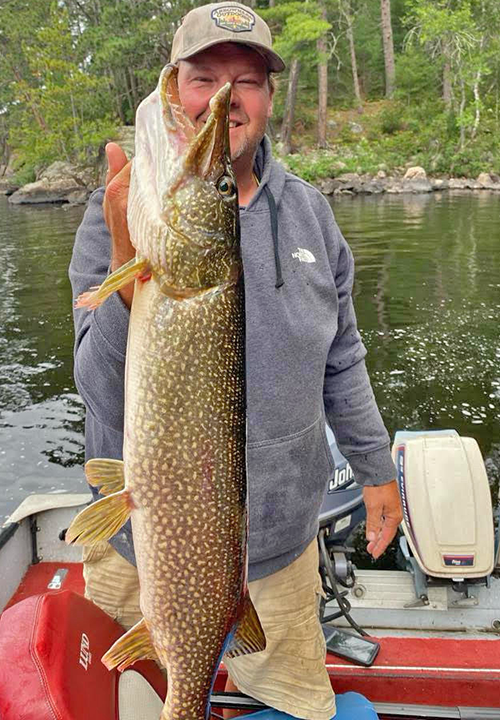 "Walleye - Finally, cooler, more normal temps have returned to the Ely area, which has helped the walleye bite on many Ely area lakes. Anglers have been reporting that they are starting to find some walleyes in the 12 to 20 foot of water range on large flats close to deep water. Here larger minnows on a lindy rig or a jig has been very effective. Reports of crawlers working well for anglers continue to come in. For crawlers, spinner rigs have been the way to fish them. Gold, gum ball, and orange/chartreuse have remained popular colors for anglers.
"Walleye - Finally, cooler, more normal temps have returned to the Ely area, which has helped the walleye bite on many Ely area lakes. Anglers have been reporting that they are starting to find some walleyes in the 12 to 20 foot of water range on large flats close to deep water. Here larger minnows on a lindy rig or a jig has been very effective. Reports of crawlers working well for anglers continue to come in. For crawlers, spinner rigs have been the way to fish them. Gold, gum ball, and orange/chartreuse have remained popular colors for anglers.
Smallmouth - Smallies have been the hottest bite happening right now. Smallies continue to be found in all classic smallmouth locations, but sunken islands with deep water around them have been the best location to find the really aggressive smallies. Out here, medium suckers or creek chubs have been deadly on the giant smallies. Tip these minnows on a jig or lindy rig and hang on!
Panfish - Crappies seem to be schooling up a little more this last week as anglers reported higher catch rates this last week. Cabbage beds have been the best location to find crappies, but standing timber has also been a good location to find crappies. Jig/twisters, beetle spins and the classic, crappie minnows under a bobber have been the way to go for crappies.
Stream Trout - Rainbows continue to be a popular catch for stream trout anglers this last week. Anglers fishing a night crawler, 5 to 10 feet under a bobber, or floating one off the bottom, have had very good luck. Anglers fishing from a boat have simply been trolling small crankbaits, over deep water, and having very good luck.
Pike - Pike fishing has been a little bit hit or miss this last week for pike anglers. Some really big pike have been landed this last week, but there have been a fair amount of hammer handles caught too. Large suckers fished under a bobber and floated in shallow bays, rocky points or near river mouths have been effective on big pike." — Arrowhead Outdoors, 218-365-5358
 Lake of the Woods, LOW Tourism September 25, 2024
Lake of the Woods, LOW Tourism September 25, 2024
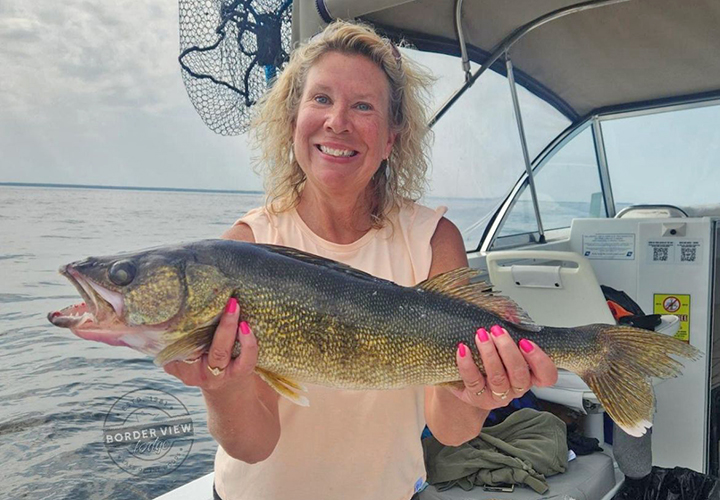 "In a nutshell, walleye and sauger fishing has been awesome on the south side of Lake of the Woods. If you want to catch fish, the bite is on. Anglers are finding fish ranging from 18 to 29 feet of water. The cooling water temperatures after a brief fall warm spell are down to about 64 degrees.
"In a nutshell, walleye and sauger fishing has been awesome on the south side of Lake of the Woods. If you want to catch fish, the bite is on. Anglers are finding fish ranging from 18 to 29 feet of water. The cooling water temperatures after a brief fall warm spell are down to about 64 degrees.
Again this week, many anglers have reported success jigging with frozen emerald shiners, but fathead minnows are also working well too. Areas from right in front of the Lighthouse Gap where the Rainy River enters Lake of the Woods west to the Morris Point area, Zippel Bay area to Long Point. Some nice schools of fish. Many of these fish across the south shore are over mud. No structure, just a lot of forage that holds the fish. Get out amongst the fish, anchor up and get your jig on.
Prominent jig colors this week are gold, chartreuse, orange, and pink. Gold combined with a color is often a good choice too. Drifting spinners / crawlers or trolling crankbaits is still effective for many anglers. Some nice perch and occasional pike are being caught mixed in with the walleyes and saugers.
The Rainy River is producing some nice walleyes, but with the warmer temps, not the big traditional run as of yet. There are definitely some nice fish in the river however and it will only get better as water temps cool and days get shorter. The river is relatively small and a nice option for most sized boats. Depending upon the day, Four Mile Bay and even the south shore is accessible depending upon the wind which varies day to day.
Sturgeon fishing continues good and should pick up as water temps cool. The sturgeon "keep" season goes through September 30, 2024. After that, it is a catch and release only season through April 23, 2025. That season extends through May 15, 2025 and then closes through May 30, 2025.
Fall up at the Northwest Angle is a special time with multi species action. Walleye fishing remains strong, with fish located across different areas with structure as well as flat areas. The deep mud east and northeast of Little Oak Island. Effective methods continue to be a mix of jigging and spinners, with crankbaits also producing good results. Pike and muskies are active in weedy areas over rocks. Jerkbaits and inline spinners are catching some good fish. Smallmouth bass are showing up strong, particularly around scattered rock areas extending from points. Tube jigs, swimbaits and crankbaits working well." — Lake of the Woods Tourism, (800) 382-FISH
 September 24, 2024 "Crappies + Sunfish + Walleyes = Happy Campers"
September 24, 2024 "Crappies + Sunfish + Walleyes = Happy Campers"
 I took Kyle and Karen Reynolds in a new (for them) direction on Monday. A couple of small, multi-species lakes where we could encounter a variety of fish that would be desirable for them to take home and eat. I figured that whatever was biting best would be the target species for the day. What I didn’t count on was that all of the fish would be biting best and we could pick and choose which ones to target based on location.
I took Kyle and Karen Reynolds in a new (for them) direction on Monday. A couple of small, multi-species lakes where we could encounter a variety of fish that would be desirable for them to take home and eat. I figured that whatever was biting best would be the target species for the day. What I didn’t count on was that all of the fish would be biting best and we could pick and choose which ones to target based on location.
The first lake, about 300 acres in size with a maximum depth of 30 fish has some of everything, but not a lot of anything. There are weed flats, steep shoreline breaks and a single mid-lake hole. Because of its small size, it doesn’t take long to troll the entire shoreline, so my plan was to explore the weed edges using spinners. I’d stop and focus on a spot using a different presentation, if there were enough fish to warrant it.
The trip around the shoreline started at a cabbage weed flat in about 10 feet of water. It didn’t take long before we had a nice crappie, and soon after that, a nice walleye. Before long, we began catching pike of small size, in large numbers, with an occasional bonus crappie, of walleye in the mix. Every spot we tried produced fish, but they all turned out to be “one hit wonders”. If I circled back to troll any area twice, the second pass was always much slower than the first pass.
Ironically the walleyes were the fish that offered the best opportunity here. Like I said in yesterday’s report though, the Reynolds’ already had 75% of their walleye limits in the freezer and by 11:30 AM, we’d gathered the remaining 3 to finish that project. We had been catching crappies, but only felt that a couple of them were large enough to harvest. The pike were plentiful, but also too small to harvest. If the pike, or the crappies would have been larger, or if we'd encountered decent size sunfish, we may have stuck around longer. But despite having good action, we decided to boogie out of there and try a lake where we might get some larger pike instead.
After a good boat cleanup, we moved to another small, 250-acre lake, also with a maximum depth of about 30 feet. Here, we had the chance to find crappies, sunfish, perch and if we got lucky, some larger northern pike. Ironically, my plan to catch larger pike resulted in us catching every other kind of fish except them. On this small lake, we found sunfish, walleyes, largemouth bass and eventually, more crappies. The northern pike that we were looking for were shy, I think we caught 2 or 3 little ones and a couple of fish that were in the protected slot.
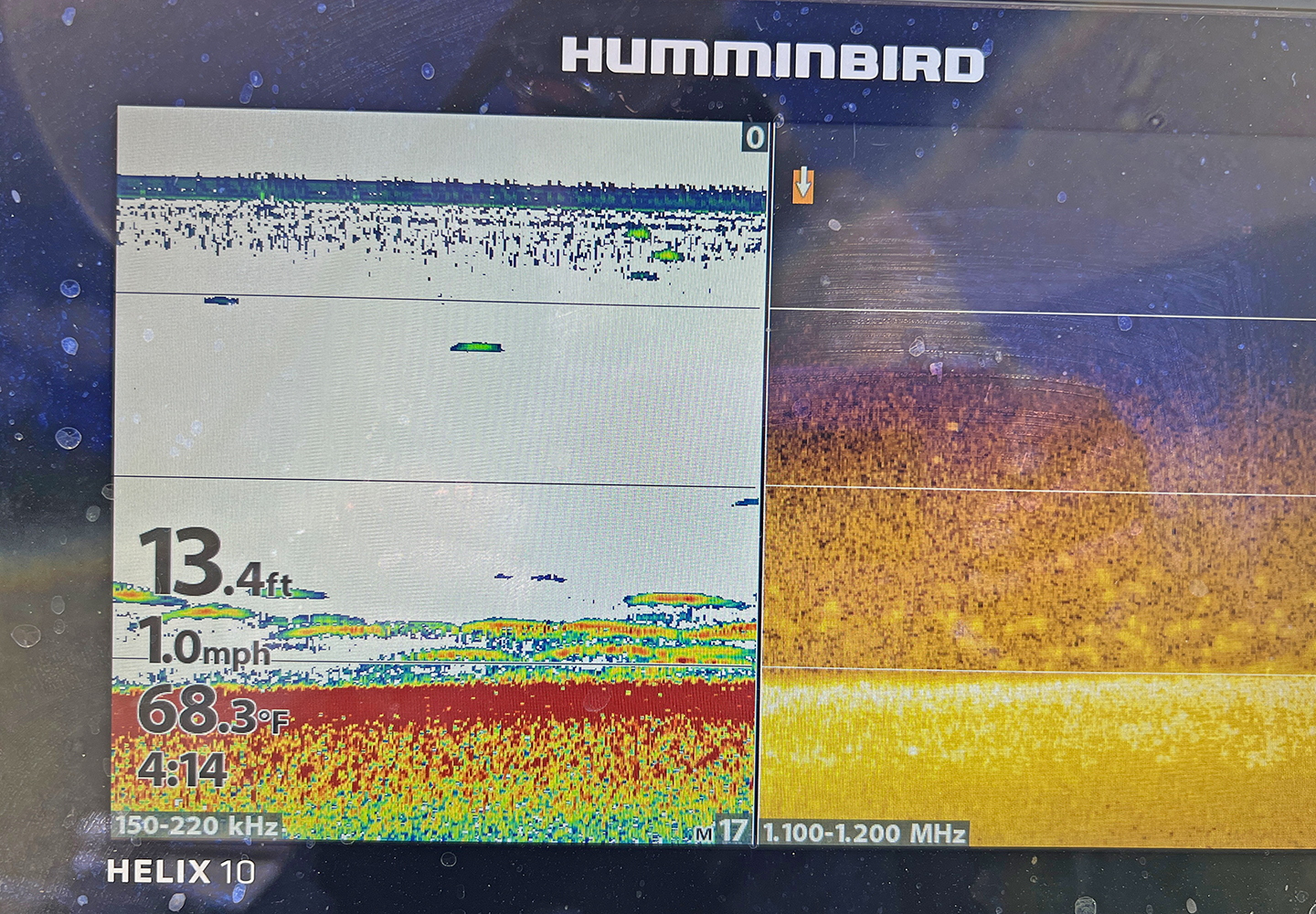 Surface water on both lakes was 68.5 degrees, the spinners tipped with minnows, our primary presentation for the day, worked fine for everything except sunfish. On lake 2 though, we fished over a shallow bar where numerous “picky” strikes occurred. I suspected that sunfish were the culprits and stopped the boat. We dropped in 1/8 ounce live bait jigs tipped with cut pieces of night crawlers and confirmed that they were sunfish. Each of us harvested 5 of the bonus sunnies, and then we resumed the search for pike.
Surface water on both lakes was 68.5 degrees, the spinners tipped with minnows, our primary presentation for the day, worked fine for everything except sunfish. On lake 2 though, we fished over a shallow bar where numerous “picky” strikes occurred. I suspected that sunfish were the culprits and stopped the boat. We dropped in 1/8 ounce live bait jigs tipped with cut pieces of night crawlers and confirmed that they were sunfish. Each of us harvested 5 of the bonus sunnies, and then we resumed the search for pike.
This time, we still didn’t find any pike, but I started marking schools of crappies along a steep shoreline break. At first, they weren’t too interested in our spinners, so we switched over to jigs tipped with plastic action tails. These fish didn’t want those either, so we put the spinners down again, this time with a slower trolling speed. At .9 MPH, we got the fish to respond and for an hour, the action was good. Like the first lake, many of the fish were smaller than we wanted, but there were 8 fish larger than the rest of the school; they now reside in the freezer awaiting their trip to Iowa.
For me, this was the first time crappies have shown an interest in moving out of the weeds and into open water. A few readers have reported too, they are starting to see more crappies in open water as well. For the next week or so, I’ll likely still start in the weeds when I’m searching for crappies but will also be sure to check out the steep breaklines adjacent to the shoreline. If you recall, there’s an article, “Following Fall Crappie Movements” that explains the strategy in great detail.
Today, the Reynolds have a day off to play golf and then they’ll fish with me on Wednesday and Thursday. So, it’s back up to Bowen Lodge for me, and my charter will certainly involve another day of chasing walleyes around Lake Winnie. Check back tomorrow and find out how it goes. ![]() — Jeff Sundin, The Early Bird Fishing Guide Office Cell Call or Text 218-245-9858 or Email
— Jeff Sundin, The Early Bird Fishing Guide Office Cell Call or Text 218-245-9858 or Email
 September 24, 2024 "How Late For Trolling Spinners?"
September 24, 2024 "How Late For Trolling Spinners?"
Q) On 9024-2024 Scott from Grand Rapids wrote" "Hi jeff, I really enjoy your blog for all the information you give. My question is how late in the year will you pull spinners? Do you have a water temperature that you go by? Thanks, scott in grand rapids."
A) Scott, depending on the species, spinners can be effective in surface temperatures all the way down to the hugh 50s. That said, I usually look forward to fishing jig and minnow, or jig and plastics presentations in fall. So, even today, I'm looking for reasons to do that instead of trolling spinners. When I feel the need to search for fish by covering water quickly, or when I fish with customers who have difficulty using "finese" type presentations, the spinners are my backup plan. Use them to explore, and when you locate fish, try alternative presentations to compare their effectiveness. Most often, the fish will tell you which presentation they prefer.
 Reader Comments September 24, 2024 "Pike Bay Report"
Reader Comments September 24, 2024 "Pike Bay Report"
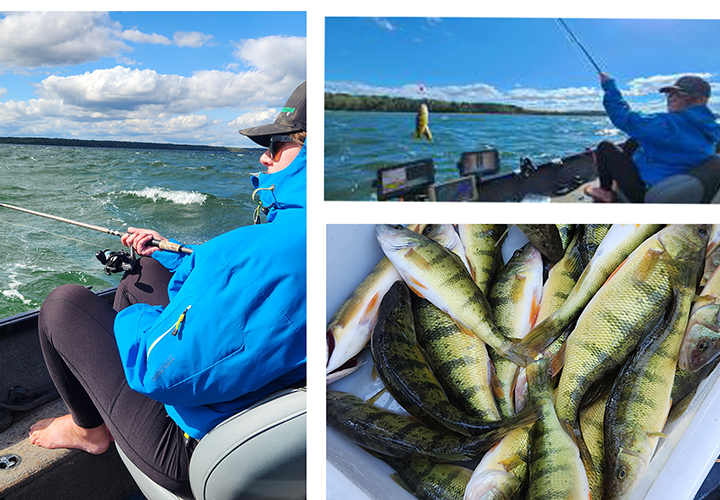 On 9.23.2024 Daniel Hamilton wrote: "Laura and I camped on Pike Bay this weekend and we had a pretty good afternoon on Saturday. We hadn't yet fished this part of the Mississippi chain but did a fair amount of research on past reports.
On 9.23.2024 Daniel Hamilton wrote: "Laura and I camped on Pike Bay this weekend and we had a pretty good afternoon on Saturday. We hadn't yet fished this part of the Mississippi chain but did a fair amount of research on past reports.
The west wind was brisk when we got on the water at 10 and by noon it was a wee bit nautical. We usually troll with the kicker pushing and the Ulterra steering. It was more a general direction than a precisice path due to how much time the trolling motor was spending with the prop out of the water.
We found a perch feeding frenzy on the stirred up west side and pink northland blades were the ticket. We managed to put together a decent bag before we ran through the 4 dozen crawlers we brought. Laura hooked a double, that's the first we'd seen that happen on a crawler harness.
It was a good weekend, and we will likely be back to do more exploring on Pike Bay next season."
 September 23, 2024 "Lake Winnie Fall Fishing Update"
September 23, 2024 "Lake Winnie Fall Fishing Update"
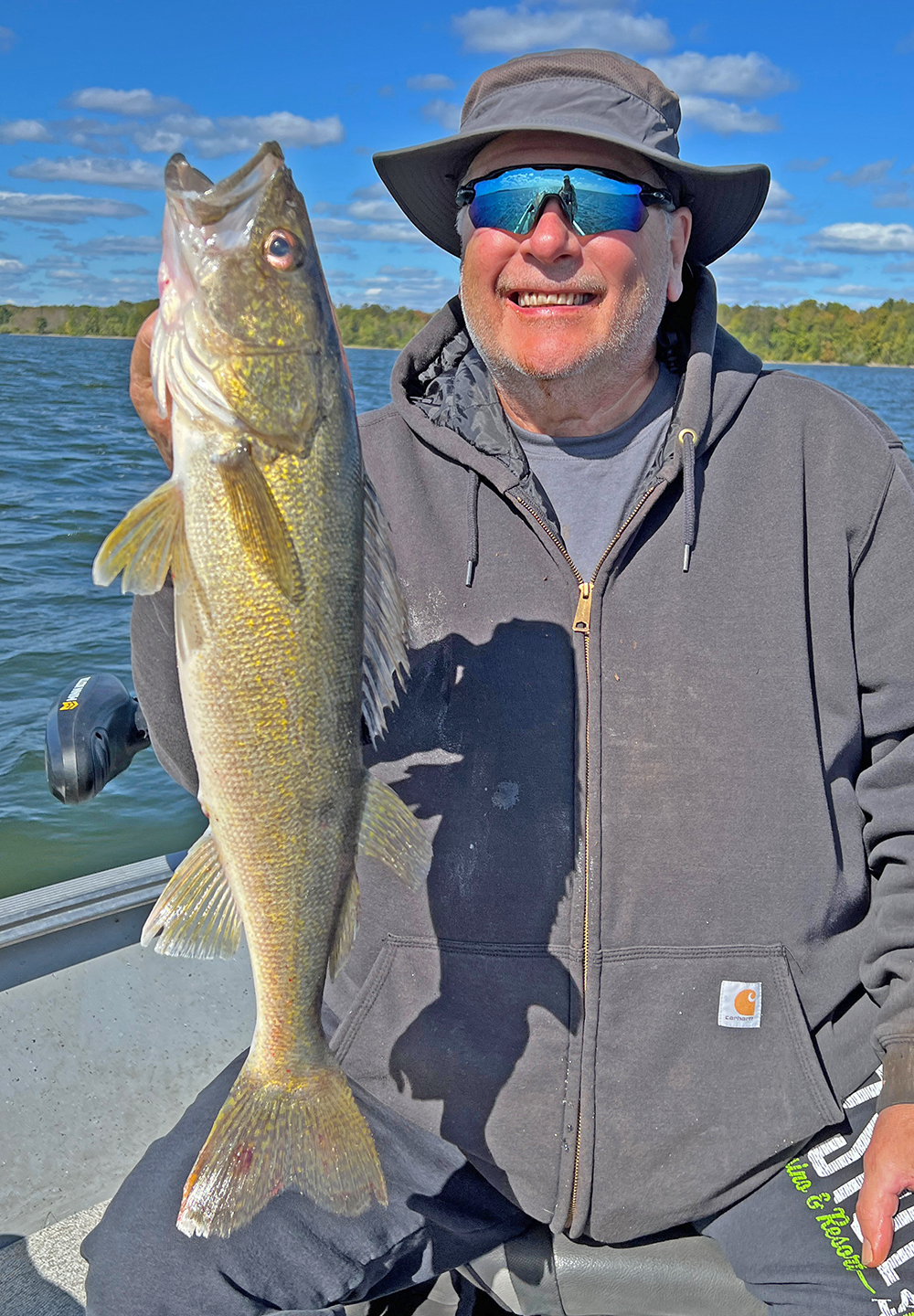 Lake Winnibigoshish absorbed the first significant cold front of the fall fishing season. As overnight air temperatures fell to the mid-40s early Sunday morning, surface temperatures dipped from about 70, down to 68 degrees. Sunny conditions then allowed the lake’s surface water to hold steady throughout the day.
Lake Winnibigoshish absorbed the first significant cold front of the fall fishing season. As overnight air temperatures fell to the mid-40s early Sunday morning, surface temperatures dipped from about 70, down to 68 degrees. Sunny conditions then allowed the lake’s surface water to hold steady throughout the day.
Fitting for the first official day of fall, there was a moderate north by northwest wind blowing. In areas exposed to the breeze, there was a light chop on the surface. West side water clarity increased somewhat, my Secchi disk, water clarity reading at Mallard Point was 7 feet deep. The algae bloom showed no sign of increasing throughout the day.
Walleye activity hadn’t changed much from what it had been before the cold front. Fish that I found were still scattered, but also still biting. Most of the time, fish that I spied on my graph struck as we passed overhead. Northern pike were active and so were perch, when we found them in breezy areas. Any perch we found in calm water were sluggish and finicky about striking.
I could see that jig and minnow presentations were working for some of the folks I saw fishing on the lake. For my crew, spinners tipped with minnows, when working, are a better choice because they require less attention to detail. We used my standard single 2/0 Aberdeen hook, behind a #3 hammered copper blade with 4 orange beads from what I could tell, the fish were equally eager to strike the spinners so that made life easier for me. Trolling at 1.1 to 1.3 MPH worked well.
We’d concentrated on walleyes for most of the day, but sometime around 3:00 PM we searched for perch. This time, trolling spinners helped us find them, but the area was small, and jigs were a better idea. The spot was a small, shallow gravel patch surrounded by eelgrass. I’ve mentioned before that perch like this type of vegetation, and they were certainly happy there yesterday.
Instead of re-writing the whole story about what eelgrass is, and what it looks like on your graph, I looked up an article from my own fishing report archives. As it happens, my September 20, 2018 perch fishing report “Perfecting the Perfect-Able” was written during a trip with the same crew, Kyle and Karen Reynolds, that I am fishing with this week. In it, you’ll learn more about eelgrass, how to find it and how to fish it.
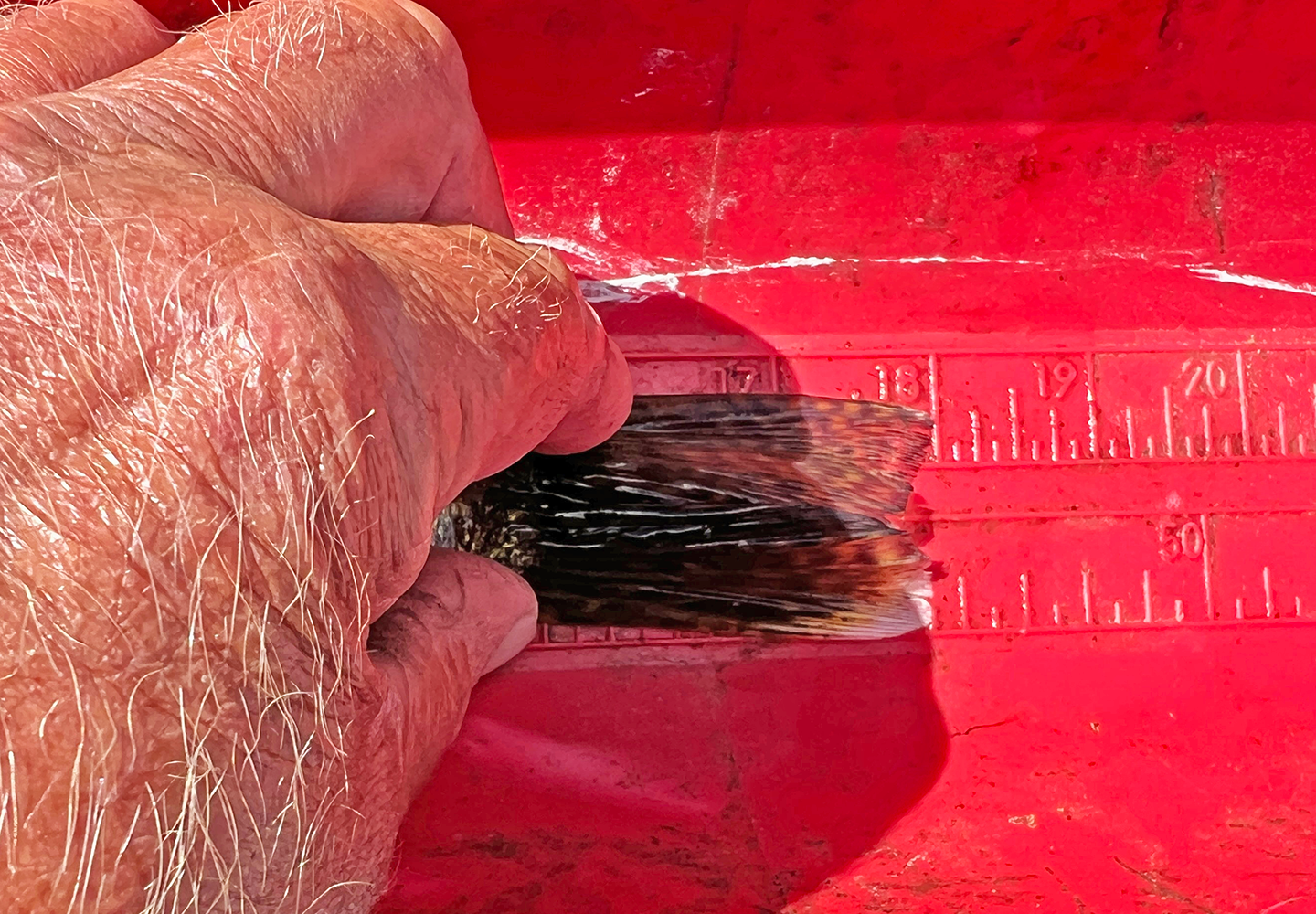 Catching fish in the “protected slot” is an ever-increasing factor for anglers fishing on Lake Winnie right now. Catching protected fish is not only a factor for walleyes either, but northern pike as well. Yesterday, we caught and released 10 or more walleyes that ranged in size from 18.0 to 18.25 inches. All of the northern pike we caught yesterday ranged in size from 22.25 to 24.5 inches. Yes, that’s right, all of the pike we caught, every single one of them, were in the protected slot. If I had randomly thrown any one of those fish into my livewell, I could have hit the jackpot with the game warden.
Catching fish in the “protected slot” is an ever-increasing factor for anglers fishing on Lake Winnie right now. Catching protected fish is not only a factor for walleyes either, but northern pike as well. Yesterday, we caught and released 10 or more walleyes that ranged in size from 18.0 to 18.25 inches. All of the northern pike we caught yesterday ranged in size from 22.25 to 24.5 inches. Yes, that’s right, all of the pike we caught, every single one of them, were in the protected slot. If I had randomly thrown any one of those fish into my livewell, I could have hit the jackpot with the game warden.
The takeaway from today’s update is that Winnie took another step in the right direction. I don’t like to use terms like “the fall bite is on”, but I do believe that we are on the verge of seeing an uptick in fish activity. I expect you’ll be seeing good reports coming in over the next few weeks, but you won’t see one from me tomorrow. I’ll be fishing again today with Kyle and Karen, and with ¾ of their walleye limit already packed and frozen, we’ll be looking for something “different” to do. I’m hoping to find a multi-purpose lake where we can catch a little bit of everything. I’ll let you know how that works out as soon as I know how it works out. ![]() — Jeff Sundin, The Early Bird Fishing Guide Office Cell Call or Text 218-245-9858 or Email
— Jeff Sundin, The Early Bird Fishing Guide Office Cell Call or Text 218-245-9858 or Email
 September 22, 2024 "Plunge Into Fall: Swan Dive, or Belly Flop?"
September 22, 2024 "Plunge Into Fall: Swan Dive, or Belly Flop?"
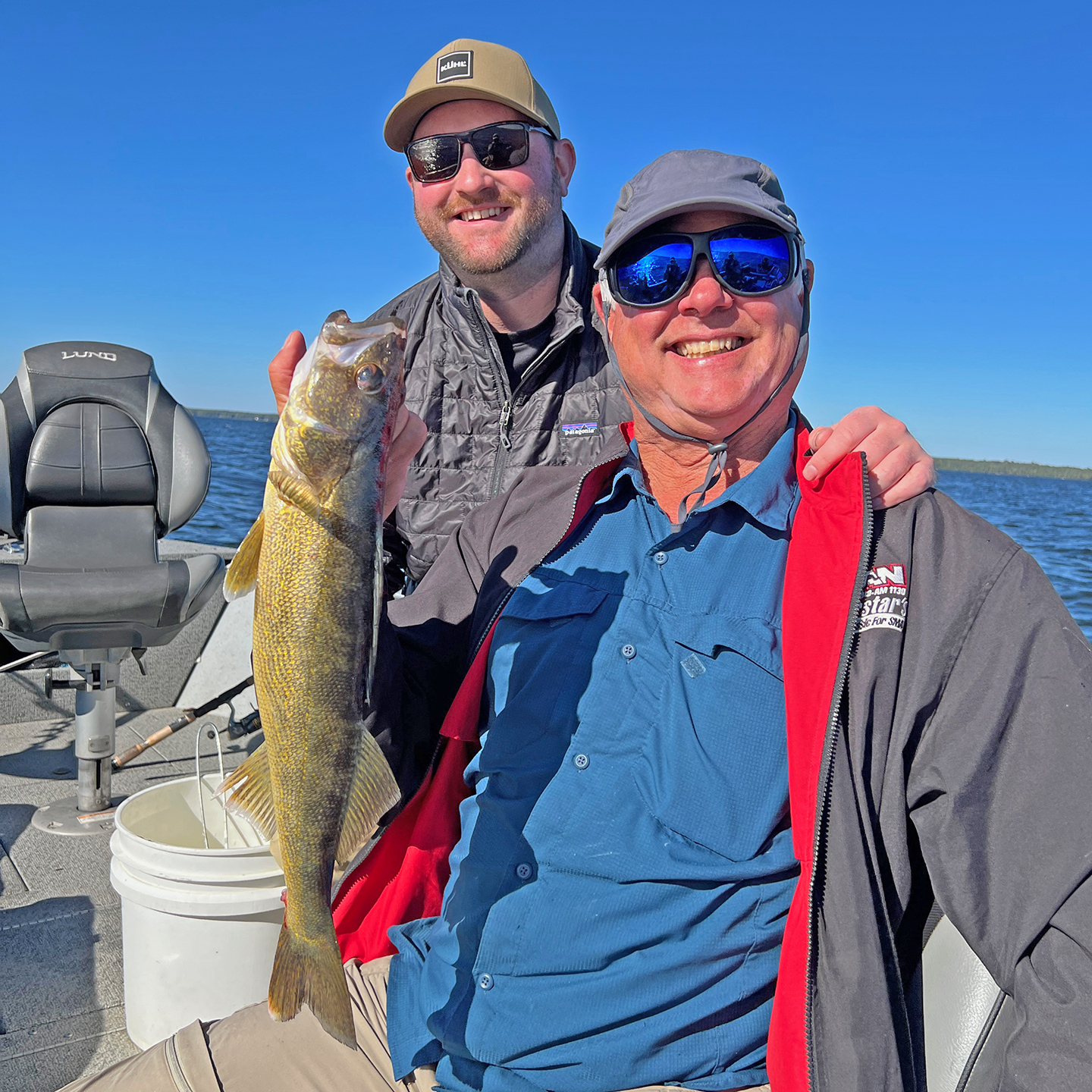 Meeting new customers is intimidating for me, especially on days when there’s been a major weather change. Intimidating too, is when the new customers request fishing on a lake that I haven’t fished for a while, or even sometimes, never at all. It usually works out fine in the end, but that doesn’t stop me from worrying about it, like I did on my way to Bowstring Lake on Friday morning.
Meeting new customers is intimidating for me, especially on days when there’s been a major weather change. Intimidating too, is when the new customers request fishing on a lake that I haven’t fished for a while, or even sometimes, never at all. It usually works out fine in the end, but that doesn’t stop me from worrying about it, like I did on my way to Bowstring Lake on Friday morning.
Mark and Jim Danielson, who I met for the first time at the landing on Bowstring, would be hopping into my boat just a couple hours after a series of thunderstorms rolled through the region. The cool wind, blowing hard out of the west, was the first change after a week of stable, southerly winds and warm temperatures. The goal, catching walleyes, of course, was complicated by the fact that I hadn’t been on Bowstring in about 6 weeks. Luckily, this trip worked out well in the end, but not without some effort, and not without the power of positive thinking.
As we left the dock, the surface temperature was 71 degrees, and there was a somewhat heavy algae bloom. The forecast west winds weren’t too strong yet, so I decided to fish as many places on the east end as possible, hoping not to get blown out too soon. The trip over to the rock pile was pleasant, and when we arrived there, conditions were favorable. There was a chop on the surface, but backtrolling with spinners would be do-able.
During the first 15 minutes, I thought it might be an easy day. I picked up one decent walleye, we caught a keeper size perch, and the usual pack of pickling size pike kept us busy. The wind caught up to us fast though, and before long, trolling had become impossible. I moved up the shoreline to get out of the hard wind and switched over to jigs and minnows for a drift. Drifting was out of the question too, at 1.7 to 2.0 MPH, the only fish that could catch us were skinny, starving northerns.
With about 2/3 of the lake off limits because of the whitecaps, I did the only thing I could, trolled the weed edges and breaklines on the west side, hoping to get lucky. Every place we stopped worked out about the same, we caught lots of northern pike. We did catch walleyes at a couple of places, but they were too small to harvest. Mark picked up a nice crappie too, but that was the only one we found. By now, it’s midafternoon, and I’m worried, but my crew wasn’t. In my mind, it’s a tough day, but every step of the way, they’ve been smiling and chatting and asking questions, and they said that compared to their “normal” fishing trip, the action has been pretty good.
At one stop, I told mark that I’d be happy if I could just find one school of fish where we could pick up a half dozen keepers. Mark said, “I’d be happy, no we’d be happy with … well, we’re just already happy.” They were happy too, I could feel it, and the happier they were, the more I wanted to please them. So now I’m really getting determined to find that spot, and this is when I catch my lucky break. The wind laid down, the rollers turned to a light chop and was able to head back to the east side of the lake. “I wanted to try this breakline earlier, but the wind caught me before I had a chance,” I told Mark.
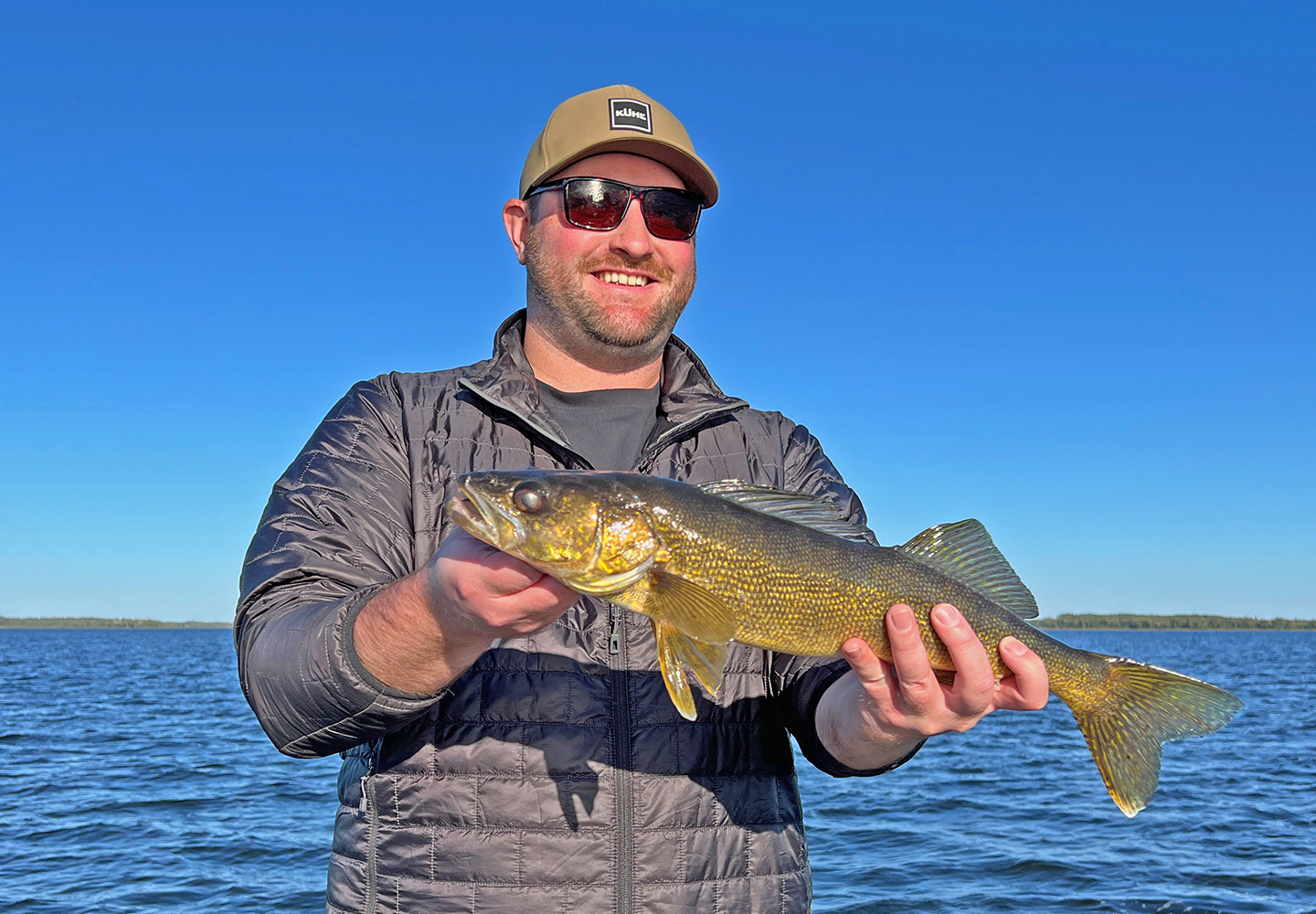 When we arrived at the spot, a point along the edge of a weedy flat, we trolled spinners again. In about 7 feet of water, I picked up another walleye and the pike were plentiful. After a couple of passes without another walleye, we picked up and moved to the deeper breakline. Scanning the breakline, we noticed a school of fish holding in about 12 feet of water. They were a little too deep for the spinners we had rigged, so we switched back over to jigs and minnows. I backtracked to get in position for a drift, and within a hundred feet or so, picked up another walleye, things were looking up.
When we arrived at the spot, a point along the edge of a weedy flat, we trolled spinners again. In about 7 feet of water, I picked up another walleye and the pike were plentiful. After a couple of passes without another walleye, we picked up and moved to the deeper breakline. Scanning the breakline, we noticed a school of fish holding in about 12 feet of water. They were a little too deep for the spinners we had rigged, so we switched back over to jigs and minnows. I backtracked to get in position for a drift, and within a hundred feet or so, picked up another walleye, things were looking up.
I can’t recall the exact order, but we caught and released several smaller walleyes, and Jim connected his jig with a good one, but it escaped before we could land it. Then Mark jigged up a good one, pictured here, a 19-inch fish that made his day. I picked up a couple more keepers, and now I just have one goal: to get Jim a good size walleye. The problem was the school of fish we’d found was thinning out and the bites were fewer and farther between. It’s 5:15 and I don’t have time to look for a new spot, so … “Here’s what we’re gonna do boys,” I said. Let’s put away the jigging rods and pull out the spinners, then I’ll troll us back up the breakline and see if we can find another pack of fish.”
Lines down, boat moving west at 1.1 MPH, and we’re all visualizing Jim catching a good one. At 5:24 PM I see one fish on the screen, take a deep breath, and … WHAM! That’s right, Jim, pictured here, connects with a nice size Bowstring walleye and immediately declares victory. High fives, pats on back, words of encouragement ensue. Our grand finale is accomplished, and we are headed for the dock, proud as peacocks, one and all.
You might be thinking, one walleye for Jim and one walleye for Mark doesn’t sound like a very good day. If you only measure success by how many fish in the livewell, then you’d be right, it was a tough one. If you measure success another way, by the amount of joy you derive from an experience, then this was a stellar fishing trip. I have never seen 2 men happier in my lifetime, they were happy when we started, happy when we were fishing and even happier when we finally connected with those 2 fish. For me, it was one of the most gratifying experiences of the entire season.
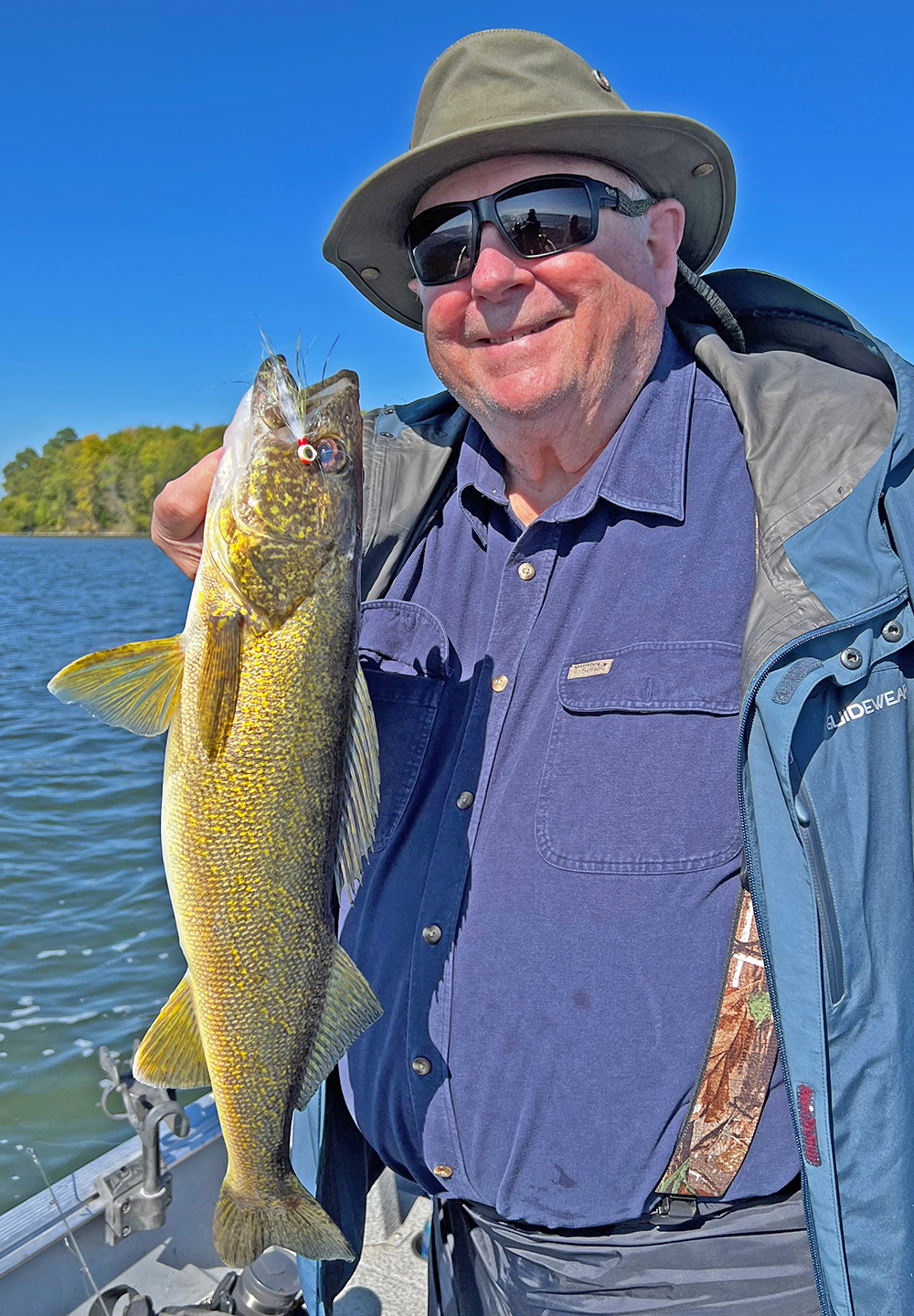 I can't say that I learned everything about what's happening on Bowstring right now. But if I was headed there today, I'd spen much less time fishing the weeds, and much for time fishing along the shoreline breaks in water depths of 12 to 14 feet. That, at least on this one trip, was where most of the fish were observed.
I can't say that I learned everything about what's happening on Bowstring right now. But if I was headed there today, I'd spen much less time fishing the weeds, and much for time fishing along the shoreline breaks in water depths of 12 to 14 feet. That, at least on this one trip, was where most of the fish were observed.
On the heels of Friday's experience, I was tempted to go back to Bowstring on Saturday, but with another strong west wind in the forecast, opted out of that notion. I headed to Winnie on Saturday knowing that there would be a few hours window of opportunity on the south side, before the wind would change to the west. So, I’d fish south for a little while then move to the west side where it would be calm. We’d be going with the waves on our return trip to the south end, if the wind got ripping.
The first half of the plan came together well, we had a half dozen keepers in the livewell before we moved to the west side. There, Jim Seeley picked up a big one. The bucktail jig he was using has been sort of an inside joke with us for a few years, but it was no joke yesterday. The fat 23-inch fish you see pictured here pounded it in about 4 feet of water while the breeze was still from the southeast. We picked up another keeper there too, and some nice bonus perch as well.
As the wind turned westerly, and the shoreline became calm, the action faded. That, combined with complications caused by heavy boat traffic sent me headed north toward the Third River. Much like my experience on Friday though, the wind blew so hard that fishing in it was darn near impossible. We tried to hold steady on a couple of spots, and did pick up a couple more fish, but didn’t last long.
The trip back to Nodaks was not a rough one because we were rolling with the waves. But the scenery was wild and woolly, 4-to-5-foot waves were giving the lake a good shake. I’m fairly certain that any water a half mile east of a line from the northwest shore was completely turned over by it. Now we’ll have to see whether the plunge into fall is more like a Swan Dive, or a Belly Flop. We’ll know soon enough how it affected the fish exactly, but I expect old patterns will end, and new patterns will begin.
Today, I head into my 4-day series with Kyle and Karen Reynolds. This trip represents my final chance to be a gadabout, checking new water and fishing for multiple species. I’ll let you know what we discover, as we discover it. ![]() — Jeff Sundin, The Early Bird Fishing Guide Office Cell Call or Text 218-245-9858 or Email
— Jeff Sundin, The Early Bird Fishing Guide Office Cell Call or Text 218-245-9858 or Email
 Lake of the Woods, LOW Tourism September 20, 2024
Lake of the Woods, LOW Tourism September 20, 2024
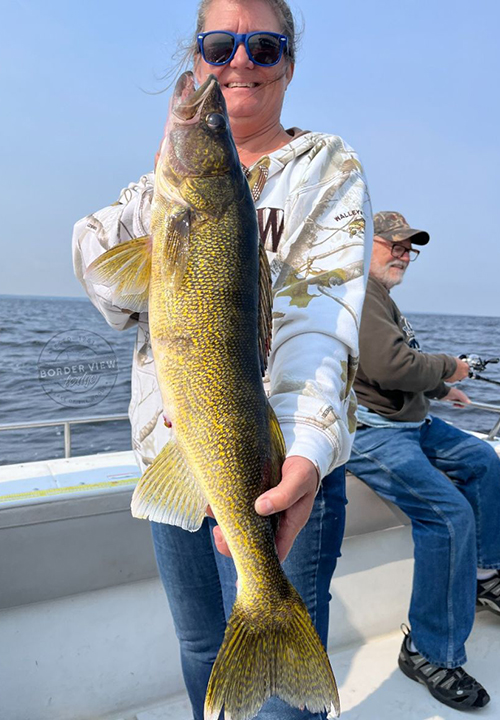 "As we move deeper into fall, the walleye and sauger fishing continues to be excellent on the south end of Lake of the Woods. Anglers are finding fish in water depths ranging from 26 to 33 feet. Cooler water temperatures have enhanced the jig bite. Prominent jig colors this week are glow red, orange, and pink. Many anglers have reported success jigging with frozen emerald shiners, specifically around the areas extending from Pine Island to Long Point. The use of sonar is helpful in locating schools over deep mud, sand and areas of structure.
"As we move deeper into fall, the walleye and sauger fishing continues to be excellent on the south end of Lake of the Woods. Anglers are finding fish in water depths ranging from 26 to 33 feet. Cooler water temperatures have enhanced the jig bite. Prominent jig colors this week are glow red, orange, and pink. Many anglers have reported success jigging with frozen emerald shiners, specifically around the areas extending from Pine Island to Long Point. The use of sonar is helpful in locating schools over deep mud, sand and areas of structure.
Drifting spinners with night crawlers or trolling crankbaits is still effective because warmer than average temps are keeping things in a transition.
As fall patterns continue, walleye movements towards the shoreline will become more evident, and the bite robust, promising excellent prospects for the season's peak jigging period approaching.
The Rainy River is producing some nice walleyes but also other species, benefiting from decent current flow and some emerald shiners in the river. Sturgeon fishing is gaining momentum with the cooler temperatures. Successful tactics involve anchoring and using a combination of crawlers and frozen emerald shiners. Key areas to target include deeper holes. Sonar is helpful to find fish as well.
The river is relatively small and beautiful to fish this time of year. Most anglers expect the fall run to start kicking in short order.
Up at the Northwest Angle, walleye fishing remains outstanding, with fish located across various structures and flat areas, particularly in the deeper mud east and northeast of Little Oak Island. Effective methods continue to be a mix of jigging and spinners, with crankbaits also producing good results.
Pike and muskies are active in weedy areas over rocks. Jerkbaits have been good as of late. The bite should only get better as water cools and days become shorter. Smallmouth bass are showing up strong, particularly around rip rap areas off points. Tube jigs, swimbaits and crankbaits have all been productive.
As the waters continue to cool, expect the fishing to only get better for all species, and particularly for jig enthusiasts." — Lake of the Woods Tourism, (800) 382-FISH
 Wired2Fish September 20, 2024 "How to Identify Size and Species of Fish on FFS"
Wired2Fish September 20, 2024 "How to Identify Size and Species of Fish on FFS"
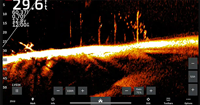 "Though I have been using it longer, I’ve become completely infatuated with forward-facing sonar over the last year and a half. My love for this new technology started during my senior year of college, and since then I’ve dedicated countless days to learning and understanding everything these units can tell you. This has been no easy task, however I’ve slowly started to piece together all the little intricacies associated with forward-facing sonar.
"Though I have been using it longer, I’ve become completely infatuated with forward-facing sonar over the last year and a half. My love for this new technology started during my senior year of college, and since then I’ve dedicated countless days to learning and understanding everything these units can tell you. This has been no easy task, however I’ve slowly started to piece together all the little intricacies associated with forward-facing sonar.
Throughout this journey I’ve learned a few different ways to identify the size and species of fish displayed by forward-facing sonar. This includes paying attention to the sonar return, as well as the fish’s behavior and positioning. These three things can tell you a lot about what’s happening underneath the water, however it still requires an ample amount of fishing time to become proficient with this technology.
One of the first things I figured out while using forward-facing sonar is ..." Learn More >> How to Identify Size and Species of Fish on FFS
 Cutfoot Sioux, Lake Winnie Fishing Report September 19, 2024
Cutfoot Sioux, Lake Winnie Fishing Report September 19, 2024
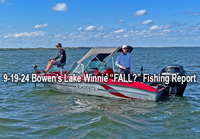 "It’s on the verge of changing, but until now, “FALL” is the furthest thing from describing the walleye fishing conditions on Lake Winnie and Cutfoot Sioux. Summer like water temperatures, strong algae blooms and warm southerly breezes are persistent this week. Walleye locations, also summer like, have been weedy flats, shoreline rocks and in some areas, mid-lake bars and humps. The weather dictates where, when and how to fish each type of structure.
"It’s on the verge of changing, but until now, “FALL” is the furthest thing from describing the walleye fishing conditions on Lake Winnie and Cutfoot Sioux. Summer like water temperatures, strong algae blooms and warm southerly breezes are persistent this week. Walleye locations, also summer like, have been weedy flats, shoreline rocks and in some areas, mid-lake bars and humps. The weather dictates where, when and how to fish each type of structure.
Surface temperatures remain warm but are again on the decline. Still rising early this week, they crossed above 70 degrees on Tuesday. By late Wednesday afternoon, cloudy conditions and windy conditions drove them back down, into the 68-to-69-degree range. Thunder is clapping this morning, and it’s raining now, so further declines in water temperatures are expected soon.
Until that happens, walleyes remain susceptible to summer trolling patterns. On weedy flats, baitfish and small gamefish are plentiful. Walleyes, perch and northern pike are there feeding heavily, and ..." Read >> Lake Winnie Fishing Report September 19, 2024 September 18, 2024 "Just Your Ordinary Perfect Day On The Lake"
September 18, 2024 "Just Your Ordinary Perfect Day On The Lake"
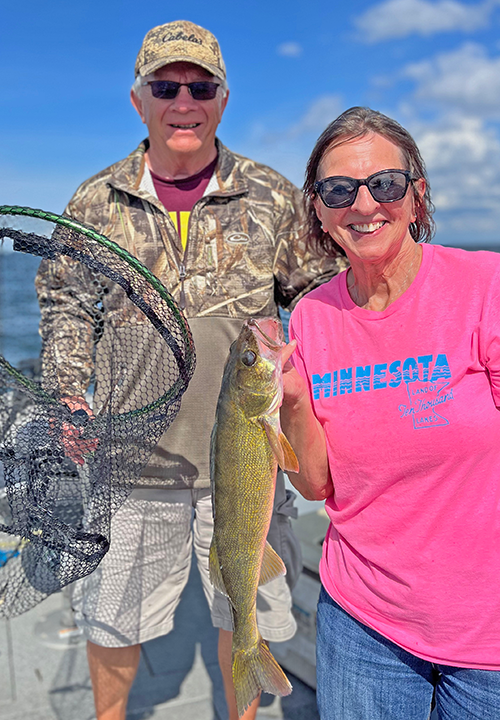 The Hommedahl’s, Karen and Erling have been fishing with me for quite a while now, since 2003 they say. Like many of my long-term customers, the relationship between us becomes less business, and more personal every year. Our fishing trip this week took another step in that direction when they agreed to let me bring the Hippie Chick along on our excursion.
The Hommedahl’s, Karen and Erling have been fishing with me for quite a while now, since 2003 they say. Like many of my long-term customers, the relationship between us becomes less business, and more personal every year. Our fishing trip this week took another step in that direction when they agreed to let me bring the Hippie Chick along on our excursion.
It’s my job to worry about the fish, and I do. So, whenever Susan joins me on a workday, I think my customers feel a sense of relief. She lightens up the mood in the boat while I ponder the perplexities of where we’ll go and what we’ll do when we get there. It usually works out well, and this Monday was no exception, the weather, the fish and the family were all in harmony.
Lake Winnie was our destination, and I know reports from there have been abundant lately. But because of the strange weather we’re experiencing this season, I decided to temporarily suspend my gadabout tendencies and focus on fewer lakes for a while. This helps everybody because I stay in contact with fish in a wider variety of spots on each lake, and can set up a route that makes sense, no matter what the weather throws at us. As it happens, it’s been a good strategy because finding small, scattered packs of fish has been the rule on Winnie, not the exception.
When we arrived at the lake on Monday, I expected to find breezy conditions that had been forecast. My game plan was to fish along some of the shoreline breaks where I’d located walleyes late last week. Instead of being windy, the breeze was calm, and the sky was blue. The surface water temperature was warm, 69.5 degrees and on the rise, by late afternoon, I was reading temperatures of 71 degrees in some areas. The warm sunny weather has encouraged a strong algae bloom, the Secchi disk reading at the south end, near Nodaks was 6 feet of water and that’s been helpful.
 Despite the bright conditions, there were still a few fish in shallow water. We managed to get started with 2 or 3 walleyes that were hungry for jigs and minnows. For all I know, we could have kept picking away at fish on the shoreline, but I decided to explore some of the mid lake structures while the lake was clam. Before the day ended, we had visited the mud hole, north long bar, the backside, horseshoe bar, moses bar, center bar and the extreme east end of sugar bar. There was never a time when we were whaling on the fish, but there was always a time when somebody picked off a single, or occasionally a pair of walleyes.
Despite the bright conditions, there were still a few fish in shallow water. We managed to get started with 2 or 3 walleyes that were hungry for jigs and minnows. For all I know, we could have kept picking away at fish on the shoreline, but I decided to explore some of the mid lake structures while the lake was clam. Before the day ended, we had visited the mud hole, north long bar, the backside, horseshoe bar, moses bar, center bar and the extreme east end of sugar bar. There was never a time when we were whaling on the fish, but there was always a time when somebody picked off a single, or occasionally a pair of walleyes.
Maybe the full moon influenced fish on this trip, or maybe it was coincidence, but on this day we boated an above-average number of larger fish in the protected slot. I’d say that for every one of our 13 “keeper” size walleyes, there was at least 1 18-1/4 to 19-1/2-inch fish released. I think these were almost all fish from the 2018-year class. Many of our “keepers” were in the 16-to-17-inch range, fish from the 2019-year class and we also released a good number of the 10 inch fish that folks have been talking about lately. Those yearlings, if they survive this winter should start reaching the keeper range sometime late in the 2025 or early in the 2026 fishing seasons.
Fish on the mid-lake structure were willing to strike jig and minnow combos. We used ¼ ounce live bait jigs tipped with golden shiners and fatheads. I couldn’t tell the difference in terms of fish preference, they both worked. For me though, fatheads if they’re large enough, are nicer. They stay on the hook better, are easier to keep alive, and tend to vary less in size.
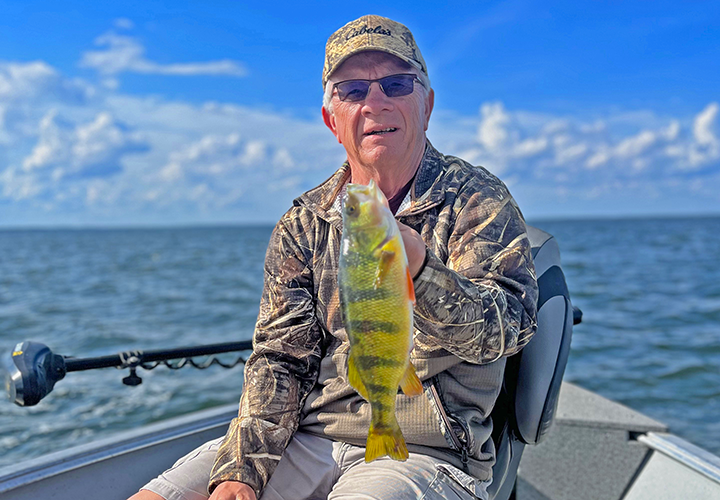 I experimented with night crawlers on Monday too and caught a couple of walleyes using them. The best way to present them turned out to be vertically, so I cut them in half and dropped them straight over the side and fished them slowly. If you like night crawlers better, or can’t find good size minnows, I think you could make a day of it using the jigs and half a crawler presentation. Leeches, if you can fish them might work too, but they’ve been scarce in these parts lately, so I don’t have any to try.
I experimented with night crawlers on Monday too and caught a couple of walleyes using them. The best way to present them turned out to be vertically, so I cut them in half and dropped them straight over the side and fished them slowly. If you like night crawlers better, or can’t find good size minnows, I think you could make a day of it using the jigs and half a crawler presentation. Leeches, if you can fish them might work too, but they’ve been scarce in these parts lately, so I don’t have any to try.
Late in the afternoon, we dropped in at Richard’s Townsite landing for a restroom break. At about that same time, the wind finally arrived, and the whitecaps started to roll across the lake. Instead of returning to the deeper water, we swapped our jigging rods for my Ugly Sticks and started trolling spinners. We trolled from the west side of Little Stony Point, out across the weed flat and ended up right in front of Nodak’s. Along the way, we picked up a walleye, some nice perch and a couple of northern pike. We likely would have caught more fish if we’d made Another trolling pass, but it was getting late and we still had a shoreline dinner planned, so we called it a day.
One takeaway for me is the Winnie’s walleyes continue to be spread far and wide. Almost everybody can find some spots that are holding some fish. Few are the days when we really catch big numbers, but rare too are the days when we don’t wind up with a respectable catch. The rule of thumb I’ve shared with my customers is that we just have to keep fishing. One stop at a time, the livewell fills and most days, we are well satisfied with the outcome.
Another takeaway for me is that perch are extremely unpredictable on Winnie right now. We didn’t fish them a lot on Monday, but in tomorrow’s report, I’ll talk about how those same fish were gone on Tuesday. So, if you like catching them, and stumble into a school of them, then you better stop and fish for them while you know where they are. At least for me, they have hardly ever been in the same places again the next day.
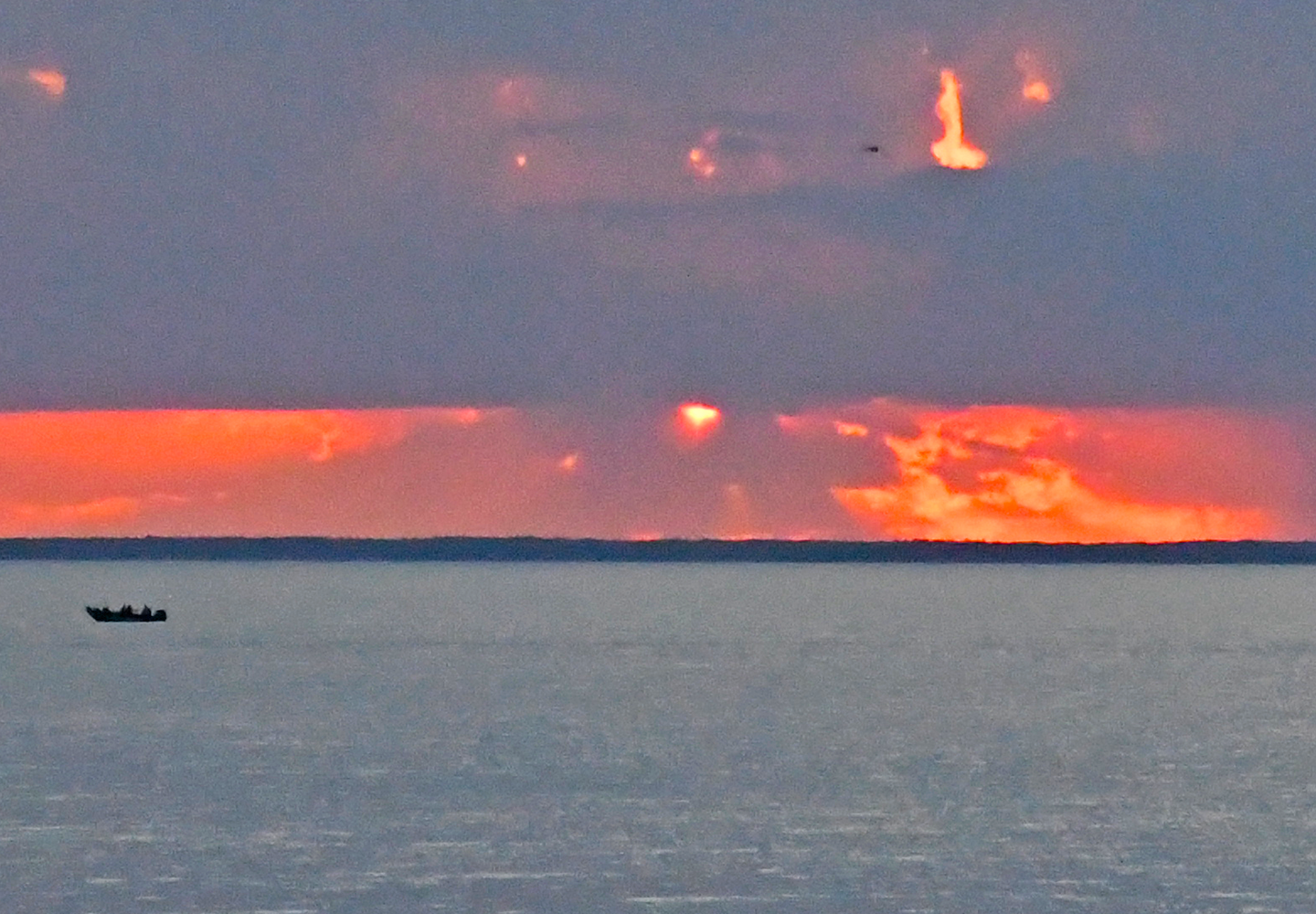 I wanted my crew to have an actual shore lunch for a change, instead of just cooking at the cabin or in some park away from the water. In recent years, finding nice places to cook fish has become difficult, but Birches landing still has a decent spot. So, we headed over there to cook fish, watch the sunset and keep tabs on other anglers on the lake. That turned out to be a nice way to end the day, it was actually really pretty; I wish there were still more spots like that one.
I wanted my crew to have an actual shore lunch for a change, instead of just cooking at the cabin or in some park away from the water. In recent years, finding nice places to cook fish has become difficult, but Birches landing still has a decent spot. So, we headed over there to cook fish, watch the sunset and keep tabs on other anglers on the lake. That turned out to be a nice way to end the day, it was actually really pretty; I wish there were still more spots like that one.
Whenever folks talk to me about cooking fish, they always focus on the recipe, but rarely ask about the oil. I know folks have their own ideas about what works best for cooking fish, but for what it’s worth, we’ve been enjoying some “old technology” lately. Last year some of my customers were raving about the shore lunches they had on a trip to Canada. Their guide used old-fashioned lard to cook the fish and they loved it, and said it was the best fish they’d ever eaten. We’ve tried it a few times now and I have to agree, it is really good.
Lard, just the name, sounds sort of bad, but we’ve been looking into it, and it’s actually a reasonable choice in terms of some healthier cooking oil choices. I love fried fish and could eat it every day. In terms of healthier choices, Susan would prefer that we cook less fried fish and more blackened, broiled and grilled fish. Still, she likes the occasional fish fry as a treat, and I can tell you this, if the Hippie Chick gives it a thumbs up, it’s not a bad idea. Look into for yourself and make your own decisions, then let us know how you liked it, or not.
The weather was gorgeous, the fish were cooperative and the dinner turned out well too. It's not that often that I’d describe anything as “perfect”, but if there is such a thing, this was it. The Hommedahl’s annual day on the lake with ME is in the books for this season. As usual, they’re on the calendar for the same day next year, but word on the street is that then, it will be the Hommedahl’s annual day on the lake with US, the Hippie Chick and me. Start the timer, 363 days and counting. ![]() — Jeff Sundin, The Early Bird Fishing Guide Office Cell Call or Text 218-245-9858 or Email
— Jeff Sundin, The Early Bird Fishing Guide Office Cell Call or Text 218-245-9858 or Email
 Ely Area, Arrowhead Outdoors Fishing Report September 18, 2024
Ely Area, Arrowhead Outdoors Fishing Report September 18, 2024
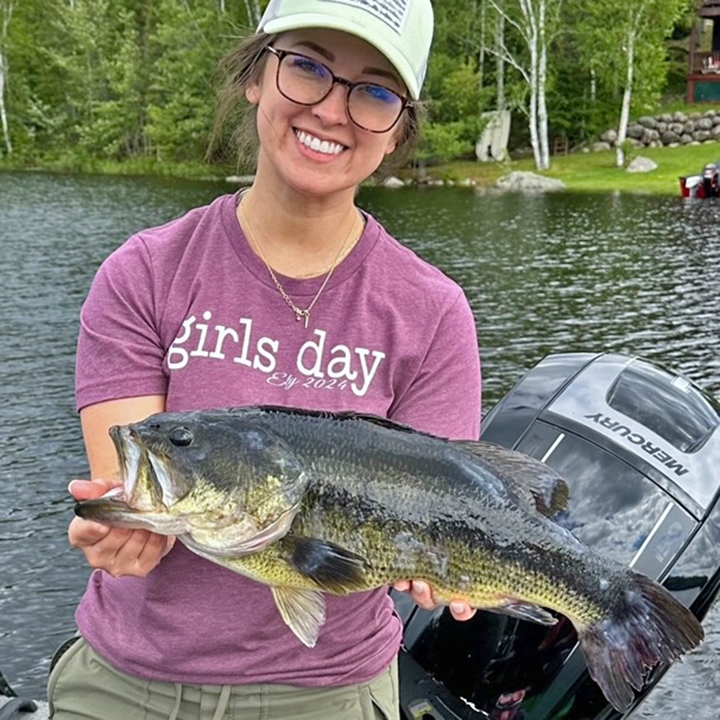 "Walleye - Very unseasonably warm temps have largely shut down the fall bite. Instead trolling small crankbaits, with leadcore, continues to be the way to go for catching walleyes. Walleyes have largely been scattered over deep mud flats in 20 to 30 feet of water.
"Walleye - Very unseasonably warm temps have largely shut down the fall bite. Instead trolling small crankbaits, with leadcore, continues to be the way to go for catching walleyes. Walleyes have largely been scattered over deep mud flats in 20 to 30 feet of water.
Smallmouth - Smallmouth fishing has cooled some too as smallies have also become more scattered with the warmer water temps. Shoreline structures like downed trees, boulder points and flats in 5 to 15 feet of water, have all been holding active smallies. Rivers too are also worth noting. In-line spinners, spinnerbaits, beetle spins and topwater baits, have all been producing fish.
Panfish - Crappies and sunfish don't seem to mind this heat wave as they have been very active for anglers. Anglers continue to find them just outside or deep in the weed beds. Small angleworms or waxies, fished under a bobber, have been very effective on those big gills.
Crappies continue to hang out just outside the deep weed edge during the day, but as the sun sets in the evening, they slide up into the weed beds to feed. Both locations they are hitting jig/twisters, beetle spins or a simple crappie minnow under a bobber.
Stream Trout - Rainbow trout have still been active, but have shifted to very late in the day, after dark or very early in the morning. Anglers continue to catch them from shore with a night crawler 5 to 10 feet under a bobber. Small spoons and jigs/twisters have also been producing here too. Anglers fishing from a boat continue to have luck catching rainbows trolling cowbells with small, bright colored crankbaits, out over deep water." — Arrowhead Outdoors, 218-365-5358
 Brainerd MN Area Fishing Report September 16, 2024
Brainerd MN Area Fishing Report September 16, 2024
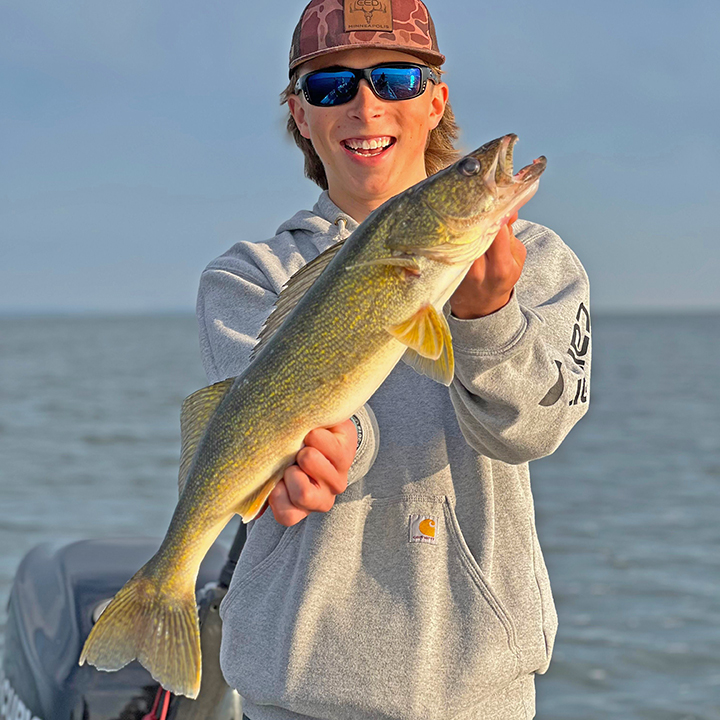 "The lakes in the Brainerd area are sitting at around 73 degrees due to the warm spell this week. Walleyes have not yet transitioned to fall patterns but they are on the verge.
"The lakes in the Brainerd area are sitting at around 73 degrees due to the warm spell this week. Walleyes have not yet transitioned to fall patterns but they are on the verge.
In the last week minnows have become the dominant bait in my boat. Working a jig and minnow along weed lines has been productive for just about anything that swims. If the wind lays down using spinners tipped with either crawlers or minnows along the weed line covering water is producing walleyes and pike.
In addition to fishing the weed lines, fishing over shallow rocks has produced some bigger fish on top but can be hit or miss. From day to day, we never know if the fish will be holding on the rocks, but is always worth checking and whe they are, expect big results.
Looking ahead the colder weather will be coming and fall patterns will begin to develop more. " — Joe Billiar, Crooked Hat Guide Service
 September 16, 2024 "Are You On Board With Forward Facing Sonar?"
September 16, 2024 "Are You On Board With Forward Facing Sonar?"
 Kip Lindberg wrote: Q) "Jeff, I've enjoyed your recent posts on Winnie, that the fish aren't as concentrated due to lots of forage, and the boat shyness (or not) due to water clarity. I've fished Winnie the last two years in early June, so I don't have any data points of what the fishing was like prior to the zebra mussels.
Kip Lindberg wrote: Q) "Jeff, I've enjoyed your recent posts on Winnie, that the fish aren't as concentrated due to lots of forage, and the boat shyness (or not) due to water clarity. I've fished Winnie the last two years in early June, so I don't have any data points of what the fishing was like prior to the zebra mussels.
My question is on forward facing sonar (ffs). I bought a loaded guide boat in 2015 end of season. It's Lund 2075 Pro Guide with a 200 hp tiller, Humminbird 998ci graph, and I put a Terrova on the front, getting rid of the Vantage (I see they no longer sell them; no wonder!).
I follow Tom Boley and the success he is having utilizing FFS has me intrigued. I fish Lac Seul every year as well, and if I see the walleyes on sonar, I can catch them. I'm much more into finding bigger walleyes, and the thought of being able to sharp shoot to a large fish definitely gets my interest.
Are you utilizing FFS or thinking about it? I would need to upgrade my electronics if I wanted to network them, but it would be beneficial if I upgraded my trolling motor as well.
I do love fishing Lake Winnie, and God willing, I will be back to Winnie in early June 2025 and expanding my knowledge of the lake. And, maybe I will have FFS to give me something new to play with. It's elk and antelope season back home in Wyoming, so my fishing is done for this year! Take care, Kip"
A) Good morning sir and thank you for the note. At this time I do not use any version of live sonar. Yes, I am thinking about it, but I'm not in any rush to get in on the frenzy.
Targeting large fish would interest me too, but depending on where and how you fish for them, could come at a high cost to the lake. The un-intended consequence of increased fish mortality cannot be overlooked. In Minnesota, folks are only allowed 1 fish over 20 inches in possession. So, repeatedly releasing fish over 20 inches, or in the case of Winnie, fish in the protected, 18 to 23 inch slot will likely result in at least some net decline in larger fish. Consider this, even though folks "believe" that they are safely releasing fish, there is always a certain percentage of fish that do not survive. Barotrauma, warm water stress and mis-handling of caught fish must be taken into consideration.
I am a staunch advocate of folks' freedom to choose and use this technology, and will never suggest limiting the availability of it. That said, I am also a staunch advocate of educating folks. In my view, technology comes with a heightened responsibility for how it is used. Like it or not, FFS is not going away, so tailoring it's use to be good for the fish, instead of bad, is paramount.
I appreciate you giving permission to share your thoughts, and I'm guessing that some of our readers will have follow up questions, which are more than welcome too. Thanks again Kip for the thoughtful note! Have a fabulous day! Jeff Sundin ![]() — Office Cell Call or Text 218-245-9858 or EMAIL
— Office Cell Call or Text 218-245-9858 or EMAIL
 September 14, 2024 "Timing the Time-Able with Dick and Paul, MMXXIV-II"
September 14, 2024 "Timing the Time-Able with Dick and Paul, MMXXIV-II"
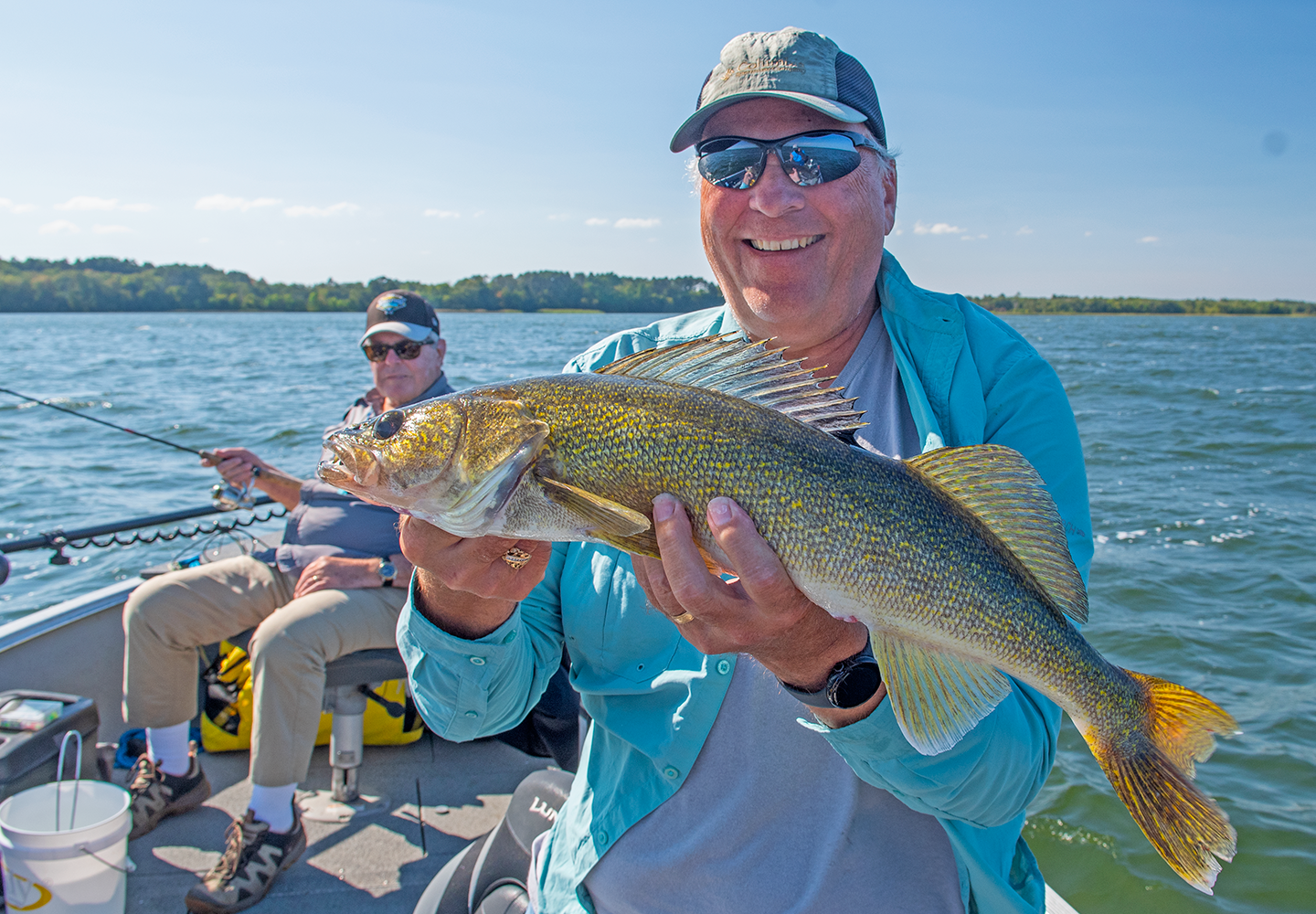 This doesn’t look much like a perch, does it? Nope, that’s because it’s not, it’s a walleye and as it happens, the largest one of the first 4 days of ‘Fun with Dick and Paul” fall fishing trip. How you catch fish like this is to go out on a mission to catch perch, and then you will catch walleyes. That’s more or less how it worked for us on Friday.
This doesn’t look much like a perch, does it? Nope, that’s because it’s not, it’s a walleye and as it happens, the largest one of the first 4 days of ‘Fun with Dick and Paul” fall fishing trip. How you catch fish like this is to go out on a mission to catch perch, and then you will catch walleyes. That’s more or less how it worked for us on Friday.
Perch are a frustrating fish, sometimes they can be so easy to catch, and other times they can be scarce as hens’ teeth. Frustrating too is that sometimes you can find them, and catch them, but they still don’t do you any good because they’re the wrong size. That happened on Friday too, perch between 9 and 10 inches long weren’t too hard to get, but fish that crossed the 10-inch mark on the ruler, those were another story altogether. Sunshine, that’s the problem, that’s what kills a great perch bite, not all perch, just the ones we really want.
Some folks think my assertion is ridiculous, they catch fish on sunny days all the time and in some ways, they’re right. At certain times of the season, or in certain waters, perch are catchable on sunny days. Lakes with dark water, heavy algae blooms and great weed beds are some of the exceptions. But perch in lakes with clearer water and lighter weed cover are more willing to gather when the skies are darker. I think it’s because perch are tuned in to crawfish, and crawfish don’t come out to play in the daylight.
Stop, I didn’t say the perch only eat crawfish, I said they are “tuned in to them” and their behavior reflects it. I believe that perch, especially large ones, are conditioned to respond to dark water conditions because they’re accustomed to finding crawfish on days like that. So, even when crawdads are not the primary seasonal forage, the conditions encourage them to move onto gravel patches where the crustations live. Once they’re moving, they’ll eat whatever they find, but when the crawfish are moving, they will go out of their way to hunt them.
Walleyes, the largest member of the perch family, respond to current. They’re conditioned to follow their noses to find easy feeding when the water is flowing. They bite better when the sky is darker too but give them a healthy “walleye chop” on the surface, and they go on the move, sometimes even if it’s sunny. I think that is why catching walleyes was easier than catching perch yesterday.
I’m playing the “coulda, woulda, shoulda” game, but if I could re-live the week, I would have used the clouds and current to my advantage last Tuesday. I guess my head was wrapped up in getting the trip off to a good start with walleyes, but if I’d known it would be a good walleye week anyway, I’d have been more opportunistic.
I’ve got one day left to find a good perch bite, and I’m looking over the weather forecast city by city, watching for the one with cloudy skies in the forecast. Let’s see, should I go north, south, west …? ![]() — Jeff Sundin, The Early Bird Fishing Guide Office Cell Call or Text 218-245-9858 or Email
— Jeff Sundin, The Early Bird Fishing Guide Office Cell Call or Text 218-245-9858 or Email
 September 13, 2024 "A Crappie Time For Dick and Paul, MMXXIV-II"
September 13, 2024 "A Crappie Time For Dick and Paul, MMXXIV-II"
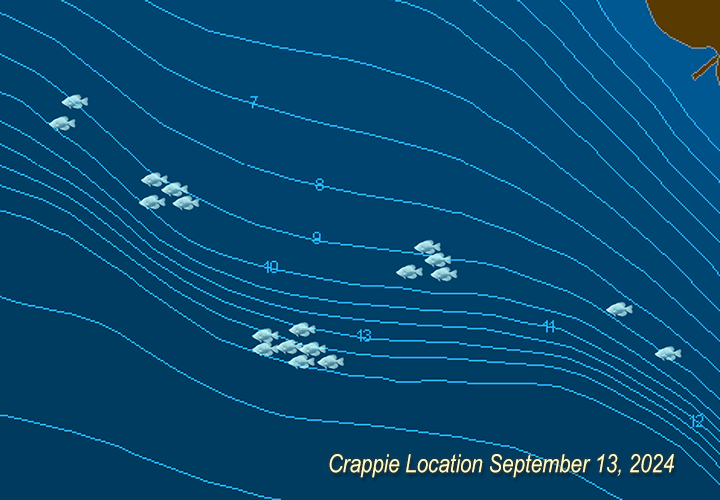 For most of the summer, I’ve posted reports like the one from (June 14, 2024 "Turning The Corner Into Summer Crappie Patterns") about a “trick” for locating schools of crappies. Finding schools of fish holding along inside corners adjacent to weed beds has been almost bullet proof, until a couple of weeks ago. That’s when I started noticing that large weed flats with slow tapering breaks into deeper water were holding more fish. Yesterday, day 3 of Fun with Dick and Paul, that new “bullet proof” pattern was the solid one.
For most of the summer, I’ve posted reports like the one from (June 14, 2024 "Turning The Corner Into Summer Crappie Patterns") about a “trick” for locating schools of crappies. Finding schools of fish holding along inside corners adjacent to weed beds has been almost bullet proof, until a couple of weeks ago. That’s when I started noticing that large weed flats with slow tapering breaks into deeper water were holding more fish. Yesterday, day 3 of Fun with Dick and Paul, that new “bullet proof” pattern was the solid one.
The lake, a medium size 1,500-acre lake is typical of north central Minnesota mixed species lakes. It has one deep basin, 3 or 4 mid-lake bars and loads of shallow, weedy flats in water depths of 6 to 12 feet. The water clarity is low, my Secchi disk reading on my last visit 2 weeks ago was just 3 feet, that’s when the algae bloom was heaviest. Yesterday it was somewhat clearer, now ranging from 5 to 7 feet depending on where we were fishing. Surface water temperatures were summer-like, 70 degrees was the average.
If there were any crappies located in open water yesterday, I didn’t see them. Weed growth on the lake was still heavy, but not super healthy looking and that’s where the fish were located. Coontail looked the best, it was still mostly green and stood tall. Flat Stemmed Pondweed was semi-green, and old looking, but still good enough to hold fish.
I’ve been looking for excuses to stop trolling with spinners and switch over to jigging presentations. But it had been a while since my last visit, and there was a lot of water to cover, so we used the spinners tipped with medium fatheads to search for fish. Several times, I spotted schools of fish on my graph, dropped a marker and stopped the boat. Fishing vertically with 1/8 jigs, we were able to pick up a few fish from most every stop. Tipping the jigs with minnows was the best, but there were fish caught using plastic tails, and a cut piece of night crawler produced several fish too.
The key depth for us yesterday was about 10 feet, give or take. There were some fish caught as deep as 14 feet, near a heavy, free-standing patch of coontail. In that area, crappies were suspended high above the bottom, held at 6 to 8 feet deep. Vertical jigging worked well there, but by late morning the wind had become very strong and vertical jigging wasn’t that much fun anymore. So, we finished off the day trolling with spinners.
The bite was steady, and if we’d been laser focused on crappies, we likely could have been wrapped up on the lake by noon. But we killed some time searching for a walleye or two, so it took us longer, I think the boys captured their 20th crappie at about 2:00 PM.
After the necessary clean-drain and dry, we arrived at Lake Winnie, hoping to quickly find some perch. The wind there was strong, and we didn’t have a lot of time, so 3 spots on the calm side of the lake was all we had time for. Trolling spinners in 6 to 8 feet of water did produce quite a few perch, but only 2 of them were large enough for harvesting. So, by 4:30, we put the search for perch on the backburner.
We’re scheduled to pick up that search for perch again today, and because we’ve eaten fish for dinner every night this week, we’re hoping to finish off the boy’s take home ration of walleyes at the same time. That means we’ll probably be fishing on Winnie, provided that there’s enough breeze blowing to keep the fish moving. If it’s too calm for Winnie, I’ll come up with something smaller with dingier water. Whatever happens, I’ll report in again on Saturday morning.
If you’re headed north this weekend to fish, expect to find more fish in summertime mode than in fall mode. Water temperatures are actually warmer now than they were a week ago, and if our crappie experience yesterday was any indication, fall haunts will not be in favor until after our next period of cold weather arrives. I see that somewhat darker skies, and breezy conditions are in the forecast for Saturday. That will be good, I think, for folks headed toward Lake Winnie, Leech, Cass and other clear water lakes in the north central region. ![]() — Jeff Sundin, The Early Bird Fishing Guide Office Cell Call or Text 218-245-9858 or Email
— Jeff Sundin, The Early Bird Fishing Guide Office Cell Call or Text 218-245-9858 or Email
 September 12, 2024 "Boat Shy Walleye vs Small Schools?"
September 12, 2024 "Boat Shy Walleye vs Small Schools?"
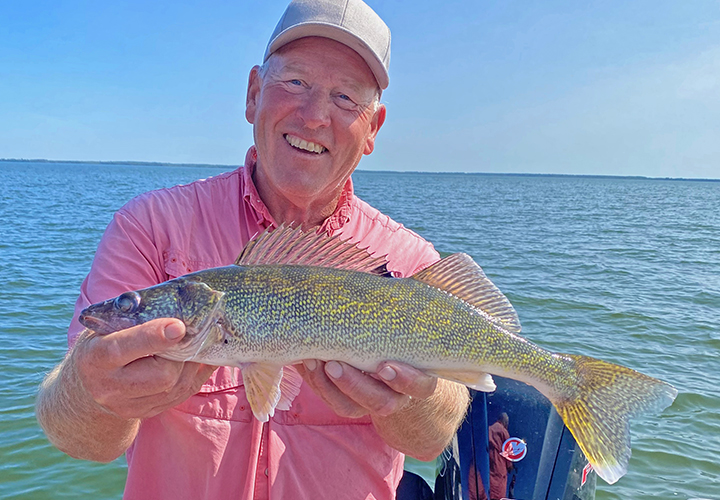 Steve Jorgenson wrote, “Jeff, I read your guest post fishing article on Bowen Lodge's website about locating walleyes in small groups, catching a few of them and then moving along to find the next small school. You suggested that the fish were active and biting, but that there weren’t enough of them to keep fishing in any given area for extended periods.
Steve Jorgenson wrote, “Jeff, I read your guest post fishing article on Bowen Lodge's website about locating walleyes in small groups, catching a few of them and then moving along to find the next small school. You suggested that the fish were active and biting, but that there weren’t enough of them to keep fishing in any given area for extended periods.
Q) My question is this, do you still think your theory is true, or do you think that there are more fish than you think, but they are wary of the boat because of clear water?
A) Steve, thank you for reading the article (9-10-2024 "If You're Happy and You Know It, Stay Right There.") and the question, it is timely, especially in that it fits into my fishing update about our trip to Lake Winnie on Wednesday (9-11-2024).
First off, yes, I do still have faith in my theory about walleyes being gathered mostly in small schools. That said though, I do also agree with you, that “boat-shyness” is part, or may be part of the trouble as well. The problem with proving either point is that the fish would have to stay perfectly still, rather than moving in and out of range of our fishing electronics.
The only thing that I do know for sure is that seeing fish on the screen of my graph has been relatively easy whenever I steer the boat along a fresh spot for the first time. Most often, I see few, if any fish on the second pass through the same area. Because of their willingness to strike, I felt that we’d simply been catching the fish that were on that spot at the time we first arrived. Admittedly, my boat passing overhead may indeed be alarming to some of them, causing them to disappear whenever I’ve tried to re-run a good spot.
Weather conditions are skewing the information too and that makes proving my theory even trickier. Contrast the past 2 days as an example. Tuesday’s weather was ideal for walleye fishing and the fish were not only easier to catch than some previous days that were sunnier, and calmer. They also allowed us to get a 2nd, sometimes even a 3rd productive drift in before the action fizzled out. On Wednesday, fish in those same areas were still catchable, but we had to work more deliberately to coax them into striking. Any time we picked up a couple of fish from a spot, going back for a 2nd pass was just time wasted.
When you think about it, a review of the circumstances this week could be used to prove either theory. One thing that takes away from the boat-shyness theory is that water clarity is fairly low on Winnie right now. When the surface is dead flat, and the sun is high overhead, I’m seeing my Secchi disk down to only about 8 feet in the middle of the lake. In some of the shallow bays, it disappears at about 6 feet and reminds me of the “good old days” before the Zebra Mussel invasion.
Along those same lines, assuming that fish are travelling in large schools, then on the good days, we should be able to make several productive drifts or trolling passes through the same areas. On Tuesday, even under ideal fishing conditions, the walleye was good for a pass or two, but then faded after 2 or 3 drifts through every spot we fished. That makes it hard for me to imagine there were any full-scale migrations of walleyes moving in.
Another way to look at it is that whether fish disappear because of wariness, or there simply aren’t a lot of them at any given location, the results are the same. Anglers who want to be more productive should make frequent moves, and avoid lingering too long anyplace, even when they’ve enjoyed a period of “good luck” there.
Steve, I’ll do what I can to refine my own theory, but I do believe your theory is equally valid too. I’ll do what I can to learn more about your ideas on the question of boat shyness too. I truly do appreciate your thoughtful and succinct comments and questions. Thank You! ![]() — Office Cell Call or Text 218-245-9858 or EMAIL
— Office Cell Call or Text 218-245-9858 or EMAIL
You Are Invited To Become A Duly Deputized Fishrapper Cub Reporter
 If you've been waiting for a gold engraved invitation to participate in the daily reports, then stop waiting and consider this your own personal invitation.
If you've been waiting for a gold engraved invitation to participate in the daily reports, then stop waiting and consider this your own personal invitation.
Helping your fellow fishermen and women stay abreast of fishing conditions in your area is good for everybody and it's easier than you think! You don't have to write a book, you don't have to share your secret fishing spots and you don't even have to mention your lake. But even a few words about general trends, seasonal patterns and local weather conditions can really help.
Be like me, become a duly deputized "Cub Reporter", it's good for fishing! Contact Us or if you prefer to be "social", Fishing Reports Minnesota, the Facebook counterpart to this page is open to the public, so you can post your own fishing update or just share a photo of a nice catch.
 September 11, 2024 "Fun With Dick and Paul, MMXXIV-II"
September 11, 2024 "Fun With Dick and Paul, MMXXIV-II"
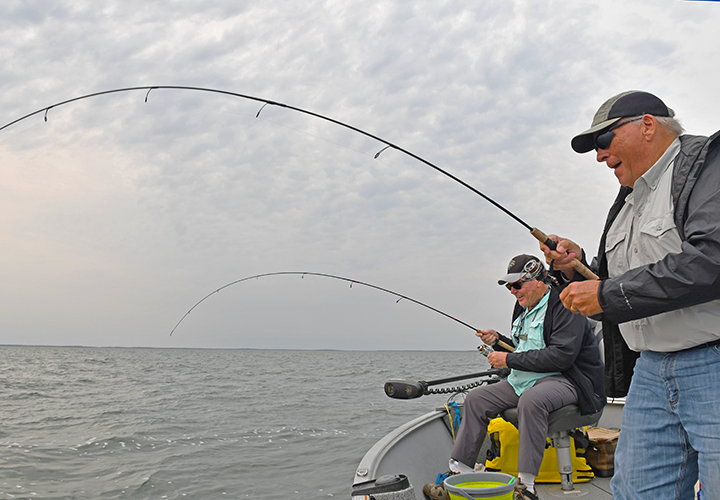 Basic observations about this photo, shared by yours truly, Cub Reporter, Staff #003-IHBFBB. The sky is cloudy and grey, there are whitecaps on the water, the Alaskan appears to be rocking, and Dick and Paul are having FUN, with a walleye double on Lake Winnie! Yes, the fall session of “Fun with Dick and Paul has begun, and the bar is set high for the next 4 days of fishing.
Basic observations about this photo, shared by yours truly, Cub Reporter, Staff #003-IHBFBB. The sky is cloudy and grey, there are whitecaps on the water, the Alaskan appears to be rocking, and Dick and Paul are having FUN, with a walleye double on Lake Winnie! Yes, the fall session of “Fun with Dick and Paul has begun, and the bar is set high for the next 4 days of fishing.
I’ve written enough about fishing on Lake Winnibigosh this week that you can get all you need from recent reports. So, if you don’t mind, I’ll just share a few of the basic details about our trip on Tuesday and call it good. If by chance you happen to have a question, or would love to share thoughts of your own, please do. Email is good, and so is texting if you prefer that, just use the contact information at the bottom of today’s update.
The surface water temperature on Winnie ranged between 67 and 68 degrees over most of the lake on Tuesday. The cooling temperatures are encouraging for jig and minnow lovers like us, and we were able to use that presentation all day long. Most of our fishing occurred in water depths between 12 and 16 feet along the shoreline breaks yesterday, and with a chop on the surface, we used ¼ ounce Lindy Live Bait Jigs to be sure we could be in the strike zone.
I don’t always feel that color is as big of a deal as others do, but on this trip, I think it made more of a difference than usual. Walleyes showed a strong preference for the solid chartreuse yellow color and had a secondary liking for the gold color. My beloved blue-glow, and glow-perch colors got the cold shoulder yesterday, I did not get a single fish while using either of them. The minnows we had were a mix of small golden shiners and fatheads. I can’t say that I loved them, but they were the best minnows we could get at the time and they worked.
The shoreline bite was good enough so that I didn’t need to spend much time looking for fish on mid-lake structure, but we did stop at one spot. Here, fishing in 16 to 20 feet of water, we encountered a small pack of hungry walleyes too. For Dick, the same ¼ ounce jig and minnow combo worked fine, for me, a ¼ ounce jig tipped with ½ night crawler provided a spurt of action, Paul, on this spot, appeared to be tasked with providing moral support, and that’s one reason I didn’t stick around too long.
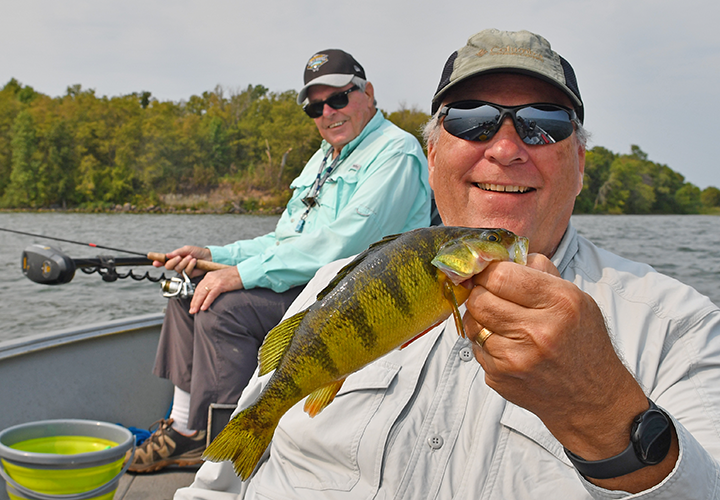 Hoping that the waves and clouds would trigger some perch action in the shallow weeds, I headed toward the west side of the lake. On and off, there have been some nice perch biting over there. The problem is that they don’t stick around in the same spots from day to day, and that was evident on Tuesday. Two of the places that provided action last week turned up empty, but there was one small pack of fish that produced some “decent” perch. There, the 5- to 7-foot-deep shoreline break contains a mix of gravel and weeds. Perch there were using the inside weedline as their headquarters.
Hoping that the waves and clouds would trigger some perch action in the shallow weeds, I headed toward the west side of the lake. On and off, there have been some nice perch biting over there. The problem is that they don’t stick around in the same spots from day to day, and that was evident on Tuesday. Two of the places that provided action last week turned up empty, but there was one small pack of fish that produced some “decent” perch. There, the 5- to 7-foot-deep shoreline break contains a mix of gravel and weeds. Perch there were using the inside weedline as their headquarters.
Last week we caught fish in areas like that using spinners tipped with minnows. Yesterday though, the breezy conditions discouraged me from pulling out the Ugly Sticks. The 1/8-ounce jig and minnow combos we substituted for spinners worked, but weeds and jigs aren’t always a fun combination. So, instead of spending a lot of time fighting them, we moved a little deeper, where the bottom was cleaner. Along the 8-to-10-foot breakline we caught some pike, and a couple more walleyes, but the only perch we found there were too small for us.
On our way out of the area, I stopped by to chat with some guys in a very nice red and black Lund Pro Guide. They were casting big plugs for pike and because I love doing that, my curiosity was piqued. Unfortunately, that crew was too serious to talk about it with me and provided only a curt reply to my question. I took the hint and moved along, but the impression they left on me was not a happy one.
For the record, if I stop by your boat to say hello, the only motivation is to share a few words of encouragement. I have no intention of moving in on your territory or sharing your top-secret information; I hope you’ll remember that. OH, and the reverse is also true. If you see us fishing on the lake and want to swing by for a quick chat, then do it; I’d love to see you.
Okay, so it’s getting near the end of the day, Dick drops a hint that he’d like to go back and try the first spot we started on in the morning. We did that, discovered that Dick’s idea was a good one, and had a couple more nice drifts there. Then called it a day and stopped by the Gosh Dam Place with some of our catch for their fish fry. They provided us, as usual, with their typically great meal and good service.
The takeaway from today’s report should be, I think, that Lake Winnie is getting ready for primetime fall action. The conditions yesterday, like they were last Saturday, were ideal for fishing. The walleyes responded immediately by going on a feeding binge, albeit a temporary one. In my mind, this is how they act during this transitional period. Calm, sunny days encourage them to sit tight in cover or on deeper structures; they are catchable, but we have to work at it. On ideal days, like yesterday, they get stupid, feeding heavily and making my life easier.
Day 2 of Fun with Dick and Paul might not be quite that easy. We’re going to take a swing at finding some crappies and it’s been a while now since I last fished for them, so it will be interesting. They’re not the biggest fans of calm and sunny weather either and that’s the forecast for today. So, I’ll have to figure out if they are still in the weeds or have begun moving out into open water, then figure out how to make them strike. Whatever happens will be the subject of tomorrow’s report, so stay tuned. ![]() — Jeff Sundin, The Early Bird Fishing Guide Office Cell Call or Text 218-245-9858 or Email
— Jeff Sundin, The Early Bird Fishing Guide Office Cell Call or Text 218-245-9858 or Email
 Ely Area, Arrowhead Outdoors Fishing Report September 11, 2024
Ely Area, Arrowhead Outdoors Fishing Report September 11, 2024
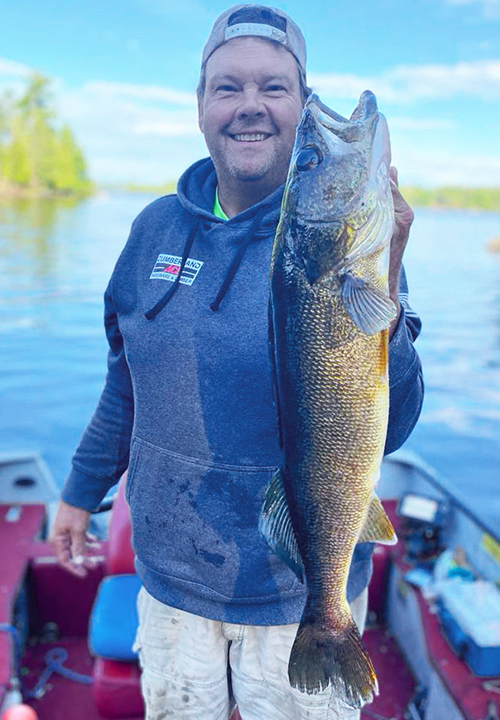 "Walleye - Walleye anglers have struggled a little this last week. Recent cold snap has pushed most walleyes down to 15-20 feet of water. Leadcoring small crankbaits has been on fire and has been the top way to catch walleyes in these depths. Anglers have been focusing on large sand or mud flats for leadcoring. Jigging large minnows has also been worth knotting. Orange/Chartreuse, Gumball, and Pink/White jigs continue to be popular colors. Anglers jigging minnows have been focusing around river mouths and sunken islands in 15 to 30 feet of water.
"Walleye - Walleye anglers have struggled a little this last week. Recent cold snap has pushed most walleyes down to 15-20 feet of water. Leadcoring small crankbaits has been on fire and has been the top way to catch walleyes in these depths. Anglers have been focusing on large sand or mud flats for leadcoring. Jigging large minnows has also been worth knotting. Orange/Chartreuse, Gumball, and Pink/White jigs continue to be popular colors. Anglers jigging minnows have been focusing around river mouths and sunken islands in 15 to 30 feet of water.
Smallmouth - Smallies continue to be the easiest fish to catch right now as smallies have begun to fatten up for winter. Smallies can now be found just about anywhere. Sunken islands, rivers, river mouths, large boulder flats, downed trees and around islands. Small suckers have been red hot for smallies, out around sunken islands, but smallies relating to shorelines have been hitting topwater, in-line spinners, spinnerbaits and large paddle tails.
Panfish - Crappies and sunfish were starting to group up with that last cold snap, but recent warm weather has spread them out again. Nonetheless anglers have been catching good numbers and quality fish, both are being found in and around weedbeds. Sunfish are hanging out inside of the weedbeds while crappies are hanging just outside weedbeds, then moving into the weedbeds during the last hour of light. Beetle spins, jig/twisters have both accounted for the bulk of panfish being caught.
Pike - Pike anglers had mixed success this last week. Fishing for big pike picked up a little during the cool snap, but has slowed up with the current warm spell. Big pike were hitting large suckers, fished under a bobber. Large spoons, large crankbaits and large spinnerbaits, fished around river mouths and main lake points has been the best technique right now.
Stream Trout - Rainbow trout continue to bite for many anglers fishing the local stream trout lakes. Anglers fishing from shore continue to catch rainbows with a nightcrawler, fished under a bobber, 5 to 15 feet down. Small spoons and jig/twisters have also been catching rainbows. Anglers fishing in a boat have been having good luck catching rainbows, trolling cowbells, tipped with a small crankbait, or just trolling crankbaits over deep water." — Arrowhead Outdoors, 218-365-5358
 September 10, 2024 "Affecting the Affect-Able" The Snyder Effect In Action
September 10, 2024 "Affecting the Affect-Able" The Snyder Effect In Action
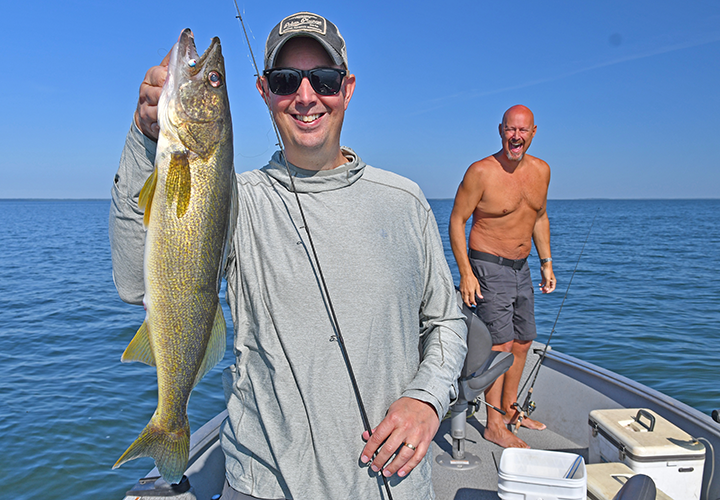 It’s been a busy September so far, and to be honest, I’ve fallen behind on writing about time spent on the water. I’ll do my best to fill in some of the gaps about fishing with the Luscious Sisters late last week as soon as I can. First though, I just have to bring up a topic I’ve written about before, “The Snyder Effect”.
It’s been a busy September so far, and to be honest, I’ve fallen behind on writing about time spent on the water. I’ll do my best to fill in some of the gaps about fishing with the Luscious Sisters late last week as soon as I can. First though, I just have to bring up a topic I’ve written about before, “The Snyder Effect”.
Long time readers will remember reports like this one, written back on June 28, 2014. In that tongue and check report, I poked fun at a hypothetical attempt to explain the Snyder Effect in a scientific way. Today though, I am here to tell you that this is no joke, the Snyder’s, however they do it, have harnessed the power of positive thinking. When they get in my boat, I don’t even bother worrying about whether we’ll have good fishing, I just trust that we will, and we do.
I’m sensing that you’re skeptical and need an example to help convince you. Okay, yesterday on Lake Winnie should have been a tough fishing day for me. The sun was high, and the sky was bright blue. There were times when the lake’s surface was mirror-glass calm and there wasn’t enough breeze to drift the boat. In 16 feet of relatively clear water, the fish should have run away and hid from us as we passed overhead, but typical of most trips with the Snyders, they didn’t. We left the lake with three hefty bags of walleye and pike fillets, plenty to feed the whole clan a few meals.
This happens every time I fish with them, cold fronts, lightning storms, bug hatches, calm seas .. whatever. No matter how worried I am that the fish won’t cooperate, they just tell me not to worry about it, they just know somehow that the fish will bite.
I don’t write about it a lot, but folks who fish with me will know that I mention the “Rainbow Fish Meditation” a lot. This term, introduced to me by my lovely and charming wife Susan, AKA “The Hippie Chick” is simply a way of communicating. We can all do it, the power is locked up in our DNA and goes all the way back to the time before we “knew” anything. A time when humans were just part of the food chain and instinct meant everything; scientific explanation meant almost nothing.
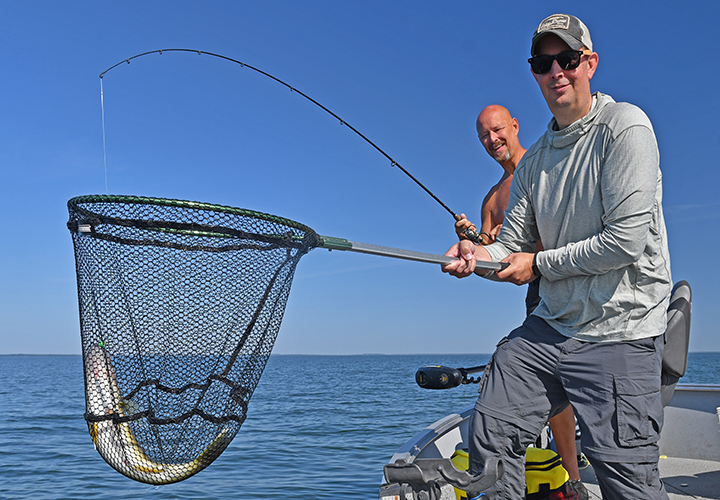 Yesterday it dawned on me that whether you call it “The Snyder Effect”, “The Rainbow Fish Mediation”, “The Power of Positive Thinking”, “An Optimistic Attitude” or anything else, it is all the same thing. Some of you already know this, but for those who don’t, here’s my suggestion. The next time you’re on the lake, and you think the fish aren’t biting, visualize that they are and that you will catch them. Communicate to them what you want, dwell on being successful, and accept what the lake is willing to share with you.
Yesterday it dawned on me that whether you call it “The Snyder Effect”, “The Rainbow Fish Mediation”, “The Power of Positive Thinking”, “An Optimistic Attitude” or anything else, it is all the same thing. Some of you already know this, but for those who don’t, here’s my suggestion. The next time you’re on the lake, and you think the fish aren’t biting, visualize that they are and that you will catch them. Communicate to them what you want, dwell on being successful, and accept what the lake is willing to share with you.
I am the first person to tell you that it’s not always easy, I get down in the dumps sometimes and dwell on the struggle. Luckily for me, I have my own Hippie Chick to coach me through those days via text messages. Often though, I can manage on my own to keep a positive outlook until I connect with the lake and its beautiful fish. I know it probably won’t be instant gratification, and will take some practice, but take a lesson from the Snyder family playbook and try visualizing success. To me, the reward for modest success on a tough fishing day is ten times more gratifying than catching a hundred fish on an easy day. Trust me, I know.
I guess I should probably mention how we caught our fish on Monday. We drifted, when possible, or slow-trolled the edges of mid-lake bars and shoreline breaks in water depths of 16 to 20 feet of water. We used ¼ ounce Live Bait Jigs tipped with small to medium size golden shiners and the jigging presentation was a subtle hop-drop-hop-drop motion.
Also notable was that Monday was the first day in a couple of months that we never used a spinner at all, only the jigs. This is a trend that will likely continue for me, especially if I fish for walleyes on Big Winnie. We may go back to spinners as a search tool, especially when looking for panfish and pike on smaller waters.
Today marks the beginning of “Fun with Dick and Paul” and that means I’ll have some time to experiment. I’ll let you know tomorrow how today works out, and what we have planned for the rest of the week. ![]() — Jeff Sundin, The Early Bird Fishing Guide Office Cell (Call or Text) 218-245-9858 or Email
— Jeff Sundin, The Early Bird Fishing Guide Office Cell (Call or Text) 218-245-9858 or Email
 September 10, 2024 "If You're Happy And You Know It ... Stay Right There!" Lake Winnie Fishing Report by Jeff Sundin
September 10, 2024 "If You're Happy And You Know It ... Stay Right There!" Lake Winnie Fishing Report by Jeff Sundin
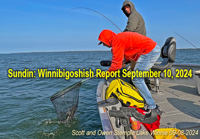 "Having a couple of days to fish with the same crew is nice for me, it allows extra time to experiment with locations and presentations. It allows more time too, for talking with folks around the resort, comparing notes about who’s doing what, and where. On these particular fishing trips, I also had a chance to learn how Winnie’s walleyes reacted to completely opposite weather conditions.
"Having a couple of days to fish with the same crew is nice for me, it allows extra time to experiment with locations and presentations. It allows more time too, for talking with folks around the resort, comparing notes about who’s doing what, and where. On these particular fishing trips, I also had a chance to learn how Winnie’s walleyes reacted to completely opposite weather conditions.
One thing I’ve learned this week is that it would be easy, after a few hours of casual fishing, to conclude that the walleyes on Winnibigoshish are not biting. Unless you were to get stubborn, like I sometimes do, and keep covering the water until you find fish. If you did that, then you would figure out that the complete opposite is true; they actually are biting well. The only trick is to realize that the fish are scattered far and wide throughout the entire system. So, instead of finding a lot of fish anywhere, we’re finding a few fish everywhere. The more spots we try, the better we wind up at the end of every day.
For a time, we experimented with jigs and minnows in deeper water. Fishing on mid-lake structure in 16 to 20 feet of water, we did find some walleyes there and they ..." Read >> Lake Winnibigoshish Fishing Report September 10, 2024
 Septenber 6, 2024 "Playing Hide and Go Seek"
Septenber 6, 2024 "Playing Hide and Go Seek"
 The Luscious Sisters, and friends, are back in town and they arrived just in time for an old fashioned, early fall cold front. Winds from the north, cool air temperatures and falling water temperatures. For me, it meant playing a game of hide and seek with fish. Some that had disappeared from their summer haunts, others that were still there, but were hunkered down and difficult to coax into striking.
The Luscious Sisters, and friends, are back in town and they arrived just in time for an old fashioned, early fall cold front. Winds from the north, cool air temperatures and falling water temperatures. For me, it meant playing a game of hide and seek with fish. Some that had disappeared from their summer haunts, others that were still there, but were hunkered down and difficult to coax into striking.
When I arrived at the landing with my morning crew, the surface temperature was 67 degrees. That’s not terribly cold but represented an 8-degree decline since my last visit, about 10 days ago. It was enough of a change to force fish into an in-active mood. Working the edges of mixed cabbage and coontail using spinners, we could get fish to strike, but not aggressively enough to inhale the hooks. The result was high bait consumption, and low productivity. All the fish, pike, panfish, crappies and walleyes were in the same mood, negative.
During the morning session, I spotted some fish that had moved out of the weeds and were set up along the deeper breakline in 20 to 24 feet of water. Thinking we could finesse them into striking, I re-rigged and passed out the jigging rods. Using ¼ ounce live bait jigs, some tipped with minnows, some with night crawlers we got snubbed again. A few fish picked at the baits, but most were not aggressive enough to inhale our lures.
Our best spot for strikes had been a 12-foot breakline, along the edges of a weed flat. Taking one last swing at that spot before switching crews, the results were somewhat better. Panfish were still sluggish, but the pike were awake, and we did catch enough of them to make life interesting. One of them, pictured here, made it into the livewell, destined to become blackened pike at the evening fish dinner.
The afternoon crew got luckier, in part because of changing to a different lake. At the second one, surface temperatures were warmer, 69.7 degrees in most areas. On this small lake, fish were still located on shallow, weedy flats in water depths of 8 to 12 feet. Sunfish, crappies and northern pike were fairly active, walleyes were not, in fact we only picked up one on this trip.
Trolling spinners was the only presentation we used here, and which fish we caught depended on the live bait we tipped them with. For crappies, medium fatheads were best, for sunfish, ½ night crawlers strung up high on the hooks worked better. Tipping the spinners with leeches worked for sunfish too, but my supply of large size leeches was too precious to use for that project. If I was going back there again, I’d bring some medium size leeches instead.
By the end of our afternoon session, we’d gathered enough fish to feed all 8 of us. Some sunnies, some crappies, and the single walleye were prepared using my shore lunch recipe. I blackened the pike, that’s a popular recipe for folks who prefer not to eat fried foods.
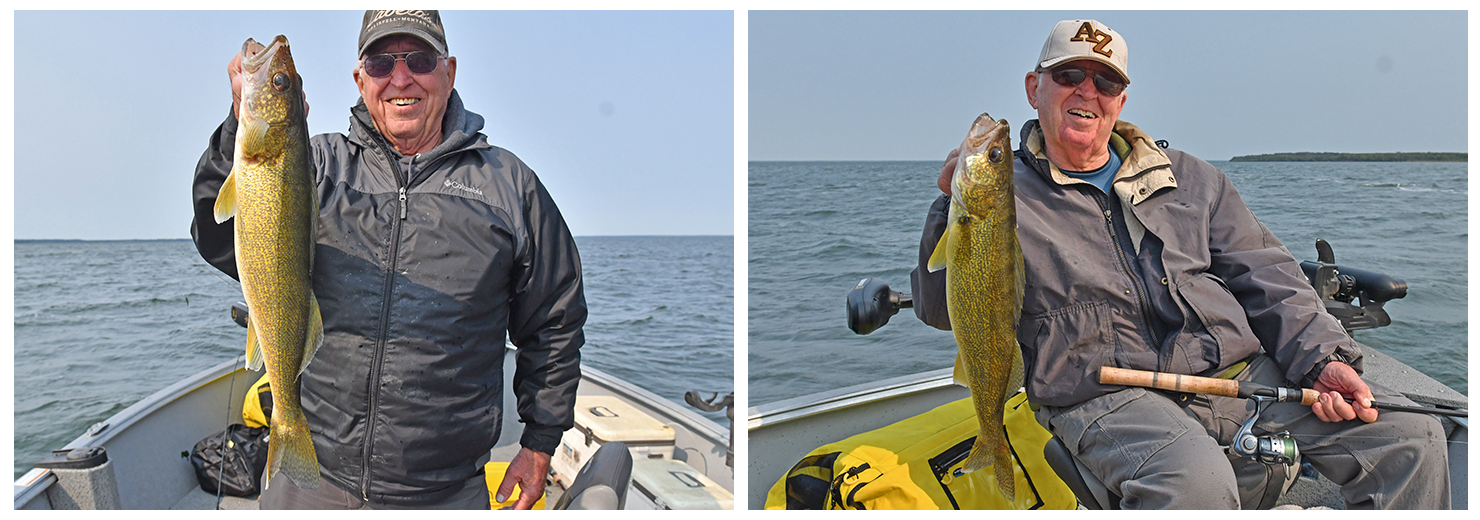 Last Tuesday, I had a trip to Winnibigoshish too. Pictured here, the Benson twins had a rewarding morning on the big lake. On that trip, our results were very similar to the most recent Bowen Lodge report, so I’ll refer you to this link for that for review. >> Lake Winnie Fishing Report August 29, 2024
Last Tuesday, I had a trip to Winnibigoshish too. Pictured here, the Benson twins had a rewarding morning on the big lake. On that trip, our results were very similar to the most recent Bowen Lodge report, so I’ll refer you to this link for that for review. >> Lake Winnie Fishing Report August 29, 2024
In a nutshell, we caught some fish in 6 feet of water, others in 12 feet of water, and a couple of them in 16 feet. We caught most of them trolling spinners tipped with fatheads, but there were a few fish caught using jigs and minnows. The jigs worked best in the shallowest water, 1/8-ounce live bait jigs tipped with small golden shiners.
On that trip, there was a strong south wind, so we didn’t move far away from Musky Bay, Duck Pass area in the southeast corner. In that region, there were enough fish to make the trip interesting, but definitely not enough to be called a good bite. Walleyes were widely scattered; depths varied a lot and there were no perch or pike to provide action between the sporadic walleye strikes. It was good enough for us because it allowed us to fish in relatively calm water, but it won’t be my first choice on the next visit.
Today, it appears that the weather will be cool again, but a lot less blustery. It’s dress up day, so calm seas and sunny skies will be perfect for the Luscious Sisters. I’m not so sure that I’ll love it though, but I’ll do the best I can with whatever I have to work with. ![]() — Jeff Sundin, The Early Bird Fishing Guide Office Cell Call or Text 218-245-9858 or Email
— Jeff Sundin, The Early Bird Fishing Guide Office Cell Call or Text 218-245-9858 or Email
 Ely Area, Arrowhead Outdoors Fishing Report September 4, 2024
Ely Area, Arrowhead Outdoors Fishing Report September 4, 2024
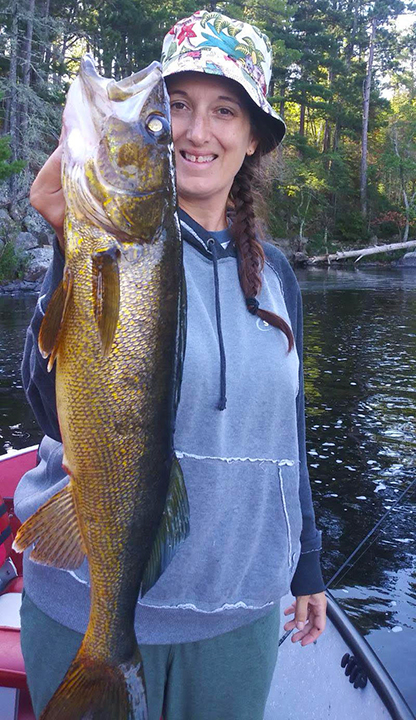 "Walleye anglers are reporting that walleyes are quickly shifting to minnows as water temps begin to drop in Ely area lake. Location continues to be on the shallow side. 10 to 15 feet of water, and at times 5 feet and even less, continue to be reported by anglers. Windy points, windy flats and river mouths. Orange, chartreuse, bubble gum and pink/white 1/4 ounce jigs, tipped with a large minnow, were very effective. Orange, chartreuse, red/white sinner rigs tipped with a crawler were also reported as being effective on walleye. Anglers have also been reporting that leadcore fishing small crankbaits has been very effective. Here anglers have been focusing on large flats in deeper water.
"Walleye anglers are reporting that walleyes are quickly shifting to minnows as water temps begin to drop in Ely area lake. Location continues to be on the shallow side. 10 to 15 feet of water, and at times 5 feet and even less, continue to be reported by anglers. Windy points, windy flats and river mouths. Orange, chartreuse, bubble gum and pink/white 1/4 ounce jigs, tipped with a large minnow, were very effective. Orange, chartreuse, red/white sinner rigs tipped with a crawler were also reported as being effective on walleye. Anglers have also been reporting that leadcore fishing small crankbaits has been very effective. Here anglers have been focusing on large flats in deeper water.
Smallmouth - Smallies continue to shift to sunken islands as temperatures continue to drop. Anglers should expect this to continue until winter. Large minnows have been extremely effective out here. Again, 1/4 or 3/8 ounce jigs, in orange, chartreuse, pink/white and bubble gum, have been very effective. Anglers not able to carry live bait or don't want to use it, topwater, in-line spinners, spinnerbaits and Ned rigs, continue to be effective. These anglers have been focusing around downed timber, large flats with boulders, river mouths and main lake points, in 5 to 15 feet of water.
Pike - Large pike continue to show up in anglers catches this last week. Anglers have mainly been finding pike patrolling weedlines in 10 to 15 feet of water with large sucker minnows, fished under a bobber, large spoons and spinnerbaits. Pike have also begun to stage at river mouths, looking for minnows to dump out of the rivers as water temps continue to drop.
Stream Trout - Rainbow trout fishing continues to be consistent on many Ely area stream trout lakes. Slip bobber and a night crawler, floating 5 to 15 feet under the surface has been very effective. Small spoons, in-line spinners and jig/twister have been very effective also. Anglers fishing from a boat continue to troll cowbells with small crankbaits for easy limits of trout.
Panfish - Crappies continue to be found hanging out just outside of weedbeds during the day, but during the evening hours, crappies quickly slide into weedbeds in search of food. Anglers targeting crappies continue to use small beetle spins, jig/twister and crappie minnows under a bobber. Sunfish continue to be found in shallow weedbeds and around downed trees. Small angleworms or wax worms, fished under a bobber remains very effective.
Lake Trout - Lake trout reports continue to be few and far between this last week. The few anglers targeting lakers have been trolling with down riggers and large trolling spoons in 40 to 60 feet of water with mixed success." — Arrowhead Outdoors, 218-365-5358
 Wired2Fish September 4, 2024 "Lithium Marine Battery Review in Lund Alaskan Tiller"
Wired2Fish September 4, 2024 "Lithium Marine Battery Review in Lund Alaskan Tiller"
 "In this detailed walk-through, Ryan DeChaine showcases the power and efficiency of lithium marine batteries, specifically in a Lund 1675 Alaskan tiller boat. DeChaine explains how they provide exceptional power and longevity in a compact size, making them ideal for various marine applications. DeChaine’s setup is a case in point. This Lund Alaskan is a do-all utility boat rigged with three power-hungry fish finders and boat control equipment. With limited in-deck storage, DeChaine was able to outfit the setup with just two lightweight and energy-dense batteries for extended runtime.
"In this detailed walk-through, Ryan DeChaine showcases the power and efficiency of lithium marine batteries, specifically in a Lund 1675 Alaskan tiller boat. DeChaine explains how they provide exceptional power and longevity in a compact size, making them ideal for various marine applications. DeChaine’s setup is a case in point. This Lund Alaskan is a do-all utility boat rigged with three power-hungry fish finders and boat control equipment. With limited in-deck storage, DeChaine was able to outfit the setup with just two lightweight and energy-dense batteries for extended runtime.
LITHIUM BATTERIES: POWER AND EFFICIENCY: Lithium batteries, particularly the lithium iron phosphate type, are known for their high energy density and long lifespan. DeChaine starts by discussing the benefits of using a Millertech 12V 190 amp-hour dual-purpose battery, which powers both deep-cycle applications like fish finders and trolling motors, as well as marine starting applications. This battery’s compact size and lightweight nature make it ..." View Video to Learn More >> Lithium Marine Battery Review in Lund Alaskan Tiller
 Brainerd MN Area Fishing Report September 4, 2024
Brainerd MN Area Fishing Report September 4, 2024
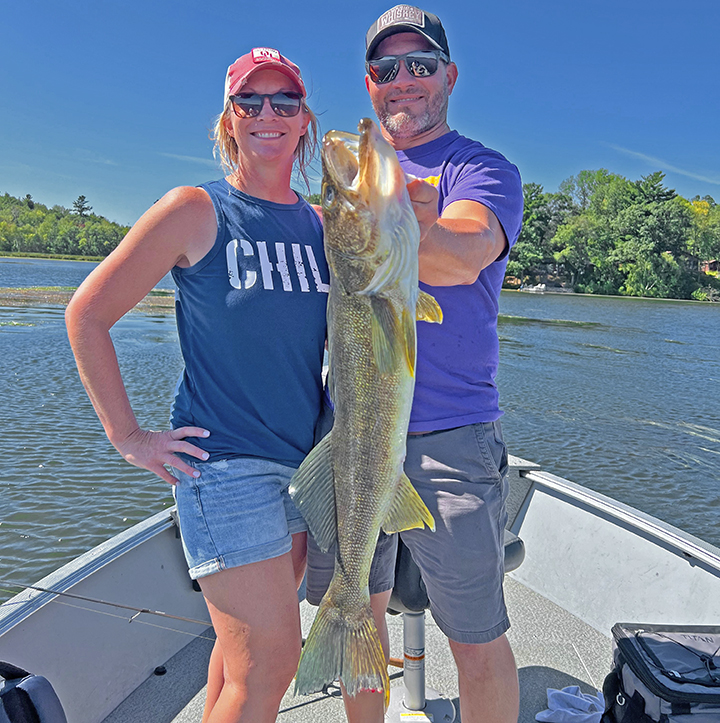 "Fall definitely feels like it’s right around the corner in the brainerd lakes area. In the mornings water temps are 70 to 72 degrees. Cooler mornings and a good breeze helped the walleye bite in the region.
"Fall definitely feels like it’s right around the corner in the brainerd lakes area. In the mornings water temps are 70 to 72 degrees. Cooler mornings and a good breeze helped the walleye bite in the region.
Staying off of larger bodies of water for the holiday weekend my clients were open to some smaller lakes for multi-species action. Bobbers in the sparse weeds on the edges of flats produced both bass on walleyes with night crawlers.
The fish were set up more on longer flats compared to sharp drop-offs and points. Working 14 to 16 feet of water and moving around after the active fish were caught kept us busy in the morning. Once action died down for mid day covering ground with spinners in the same depth rage and type of structure didn’t produce as many fish but the size of the fish increased greatly. Both worms and minnows worked equally but the minnows helped keep the annoying sunfish from stealing bait while working this depth range.
As the evening progressed bobbers once again came into play working over the same areas and slowing down keying in on the areas we previously caught walleyes. As the temperatures continue to drop minnows will come more into play and plastics will soon rotate back in as we work jigs shallow for aggressive fish.
Good luck and tight lines this week" — Joe Billiar, Crooked Hat Guide Service
 Lake of the Woods, LOW Tourism September 4, 2024
Lake of the Woods, LOW Tourism September 4, 2024
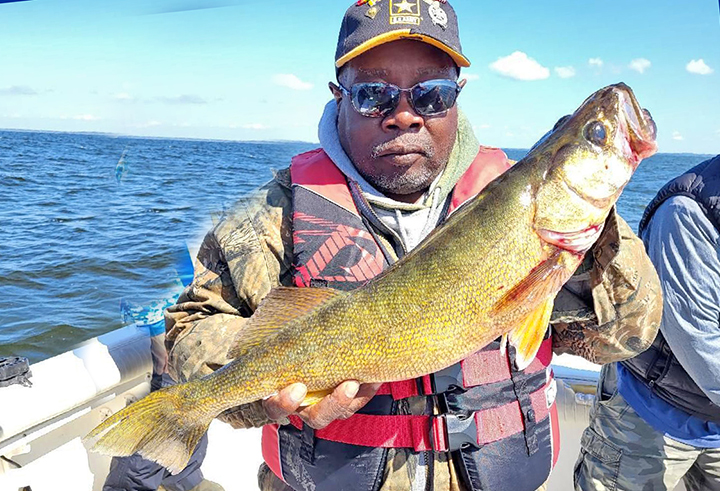 "The walleye and sauger bite remains hot across the south end of Lake of the Woods, with anglers enjoying consistent action. Good numbers of walleyes along the south shore with some big schools and some big fish. The bite has been excellent and is really shaping up nicely for the fall jig bite both on the lake and in the Rainy River. As the days progress, fish are still holding in the deeper mud, with 28 to 32 feet of water being the sweet spot this week.
"The walleye and sauger bite remains hot across the south end of Lake of the Woods, with anglers enjoying consistent action. Good numbers of walleyes along the south shore with some big schools and some big fish. The bite has been excellent and is really shaping up nicely for the fall jig bite both on the lake and in the Rainy River. As the days progress, fish are still holding in the deeper mud, with 28 to 32 feet of water being the sweet spot this week.
Jigging has really picked up in recent days. Jig colors that are producing well include gold, orange, chartreuse, and pink. Spinners and trolling crankbaits continue to yield good results, offering multiple effective strategies for anglers targeting walleyes and saugers.
For those pulling spinners, a two-hook crawler harness with spinner blades in gold, pink, orange, glow red, or glow white has been successful. Adjust your weights to 2 to 3 ounces to match the depth and breezy conditions. Trolling crankbaits remains a strong option for covering water, especially with walleyes spread across the mud flats in Big Traverse Bay. Areas with structure, such as rock reefs, or fish adjacent to these spots, are also holding fish.
 On the Rainy River, a variety of species continue to be caught on the Rainy River. The presence of decent current is still drawing extra fish into the river, and there have been positive reports from anglers targeting walleyes and sturgeon alike.
On the Rainy River, a variety of species continue to be caught on the Rainy River. The presence of decent current is still drawing extra fish into the river, and there have been positive reports from anglers targeting walleyes and sturgeon alike.
Sturgeon fishing remains productive, with anglers anchoring up and using a combination of crawlers and frozen emerald shiners. The key is patience, let the bait soak and wait for that big bite.
Walleye anglers are also having success on the river, with some nice-sized fish reported. There are already signs of emerald shiners in the river, which typically draw in walleyes. Jigging, trolling spinners with crawlers, or trolling crankbaits are all working well and will continue to be effective as the fall run approaches.
Up at the Northwest Angle, walleye fishing remains excellent. Fish are being found on the structure as well as on the flats. As always, different forage in various areas influences where these predators are focused. The deep mud east and northeast of Little Oak Island holds numbers of walleyes with mixed in perch. Good fishing around Four Blocks, and north of Garden Island as well, continuing to produce solid walleye catches.
Spinners with crawlers and trolling crankbaits are ideal for covering water and locating active fish in these areas. Anglers are finding success in 15 to 32 feet of water. The cooler temperatures, with some days dipping into the 40s, are beginning to slowly lower water temperatures, which will only increase the walleye bite as we move deeper into August." — Lake of the Woods Tourism, (800) 382-FISH